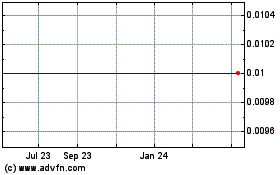0001642453false00016424532023-05-092023-05-09
UNITED STATES
SECURITIES AND EXCHANGE COMMISSION
WASHINGTON, D.C. 20549
FORM 8-K
CURRENT REPORT
Pursuant to Section 13 or 15(d) of the Securities Exchange Act of 1934
|
Date of Report (Date of earliest event reported): May 09, 2023 |

DASEKE, INC.
(Exact name of Registrant as Specified in Its Charter)
|
|
|
|
|
Delaware |
001-37509 |
47-3913221 |
(State or Other Jurisdiction
of Incorporation) |
(Commission File Number) |
(IRS Employer
Identification No.) |
|
|
|
|
|
15455 Dallas Parkway Suite 550 |
|
Addison, Texas |
|
75001 |
(Address of Principal Executive Offices) |
|
(Zip Code) |
|
Registrant’s Telephone Number, Including Area Code: (972) 248-0412 |
(Former Name or Former Address, if Changed Since Last Report)
Check the appropriate box below if the Form 8-K filing is intended to simultaneously satisfy the filing obligation of the registrant under any of the following provisions:
☐Written communications pursuant to Rule 425 under the Securities Act (17 CFR 230.425)
☐Soliciting material pursuant to Rule 14a-12 under the Exchange Act (17 CFR 240.14a-12)
☐Pre-commencement communications pursuant to Rule 14d-2(b) under the Exchange Act (17 CFR 240.14d-2(b))
☐Pre-commencement communications pursuant to Rule 13e-4(c) under the Exchange Act (17 CFR 240.13e-4(c))
Securities registered pursuant to Section 12(b) of the Act:
|
|
|
|
|
Title of each class
|
|
Trading
Symbol(s) |
|
Name of each exchange on which registered
|
Common Stock, par value $0.0001 per share |
|
DSKE |
|
The Nasdaq Stock Market LLC |
Indicate by check mark whether the registrant is an emerging growth company as defined in Rule 405 of the Securities Act of 1933 (§ 230.405 of this chapter) or Rule 12b-2 of the Securities Exchange Act of 1934 (§ 240.12b-2 of this chapter).
Emerging growth company ☐
If an emerging growth company, indicate by check mark if the registrant has elected not to use the extended transition period for complying with any new or revised financial accounting standards provided pursuant to Section 13(a) of the Exchange Act. ☐
Item 7.01 Regulation FD Disclosure.
The following information is being furnished pursuant to Item 7.01 of Form 8-K. This information shall not be deemed “filed” for purposes of Section 18 of the Securities Exchange Act of 1934, as amended, or otherwise subject to the liabilities of that section, nor shall it be deemed incorporated by reference in any filing under the Securities Act of 1933, as amended, regardless of any general incorporation language in such filing, except as shall be expressly set forth by specific reference in such filing.
On May 9, 2023, Daseke, Inc. (the “Company”) will post an earnings presentation titled “Daseke, Inc. – First-Quarter 2023 Earnings Presentation May 9, 2023” to the Company’s website at investor.daseke.com. The earnings presentation may be viewed on the Company’s website by first selecting the “Investors” tab, then “Events & Presentations.” A copy of the earnings presentation is also furnished herewith as Exhibit 99.1.
Item 9.01 Financial Statements and Exhibits.
SIGNATURES
Pursuant to the requirements of the Securities Exchange Act of 1934, the registrant has duly caused this report to be signed on its behalf by the undersigned hereunto duly authorized.
|
|
|
|
|
|
|
DASEKE, INC. |
|
|
|
|
Date: |
May 9, 2023 |
By: |
/s/ Aaron Coley |
|
|
|
Aaron Coley
Chief Financial Officer |
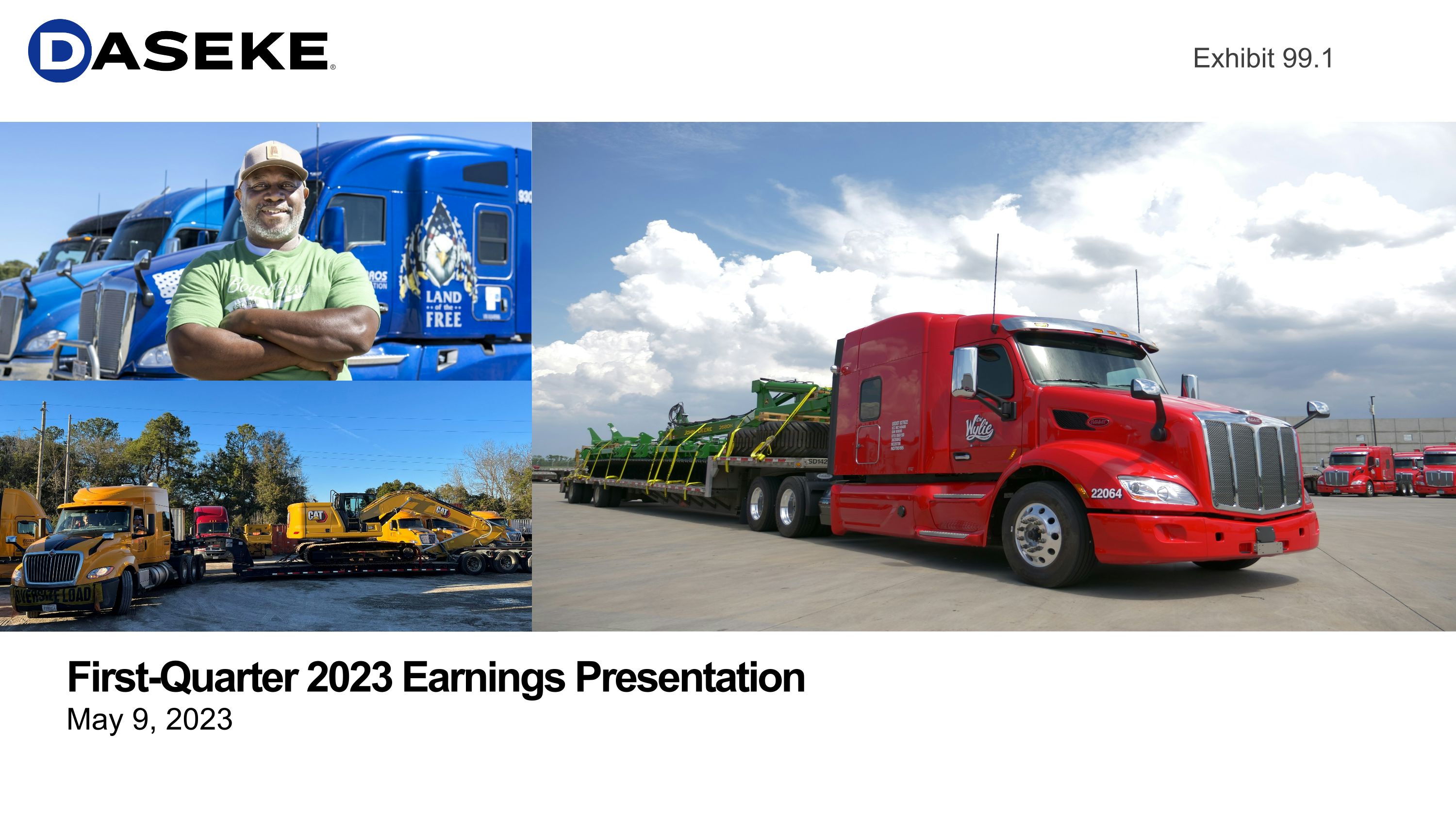
First-Quarter 2023 Earnings Presentation May 9, 2023 Exhibit 99.1
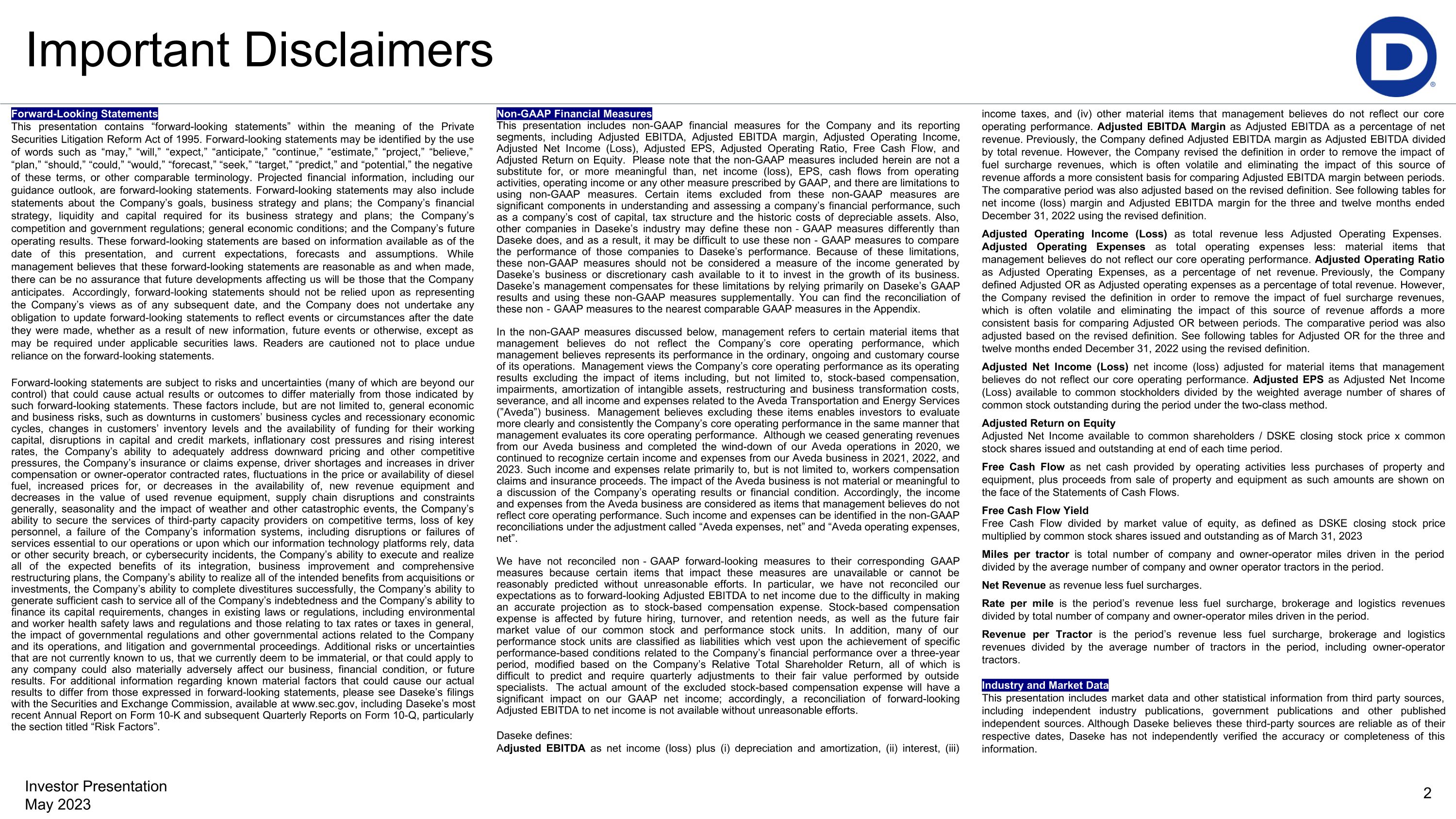
Important Disclaimers Forward-Looking Statements This presentation contains “forward-looking statements” within the meaning of the Private Securities Litigation Reform Act of 1995. Forward-looking statements may be identified by the use of words such as “may,” “will,” “expect,” “anticipate,” “continue,” “estimate,” “project,” “believe,” “plan,” “should,” “could,” “would,” “forecast,” “seek,” “target,” “predict,” and “potential,” the negative of these terms, or other comparable terminology. Projected financial information, including our guidance outlook, are forward-looking statements. Forward-looking statements may also include statements about the Company’s goals, business strategy and plans; the Company’s financial strategy, liquidity and capital required for its business strategy and plans; the Company’s competition and government regulations; general economic conditions; and the Company’s future operating results. These forward-looking statements are based on information available as of the date of this presentation, and current expectations, forecasts and assumptions. While management believes that these forward-looking statements are reasonable as and when made, there can be no assurance that future developments affecting us will be those that the Company anticipates. Accordingly, forward-looking statements should not be relied upon as representing the Company’s views as of any subsequent date, and the Company does not undertake any obligation to update forward-looking statements to reflect events or circumstances after the date they were made, whether as a result of new information, future events or otherwise, except as may be required under applicable securities laws. Readers are cautioned not to place undue reliance on the forward-looking statements. Forward-looking statements are subject to risks and uncertainties (many of which are beyond our control) that could cause actual results or outcomes to differ materially from those indicated by such forward-looking statements. These factors include, but are not limited to, general economic and business risks, such as downturns in customers’ business cycles and recessionary economic cycles, changes in customers’ inventory levels and the availability of funding for their working capital, disruptions in capital and credit markets, inflationary cost pressures and rising interest rates, the Company’s ability to adequately address downward pricing and other competitive pressures, the Company’s insurance or claims expense, driver shortages and increases in driver compensation or owner-operator contracted rates, fluctuations in the price or availability of diesel fuel, increased prices for, or decreases in the availability of, new revenue equipment and decreases in the value of used revenue equipment, supply chain disruptions and constraints generally, seasonality and the impact of weather and other catastrophic events, the Company’s ability to secure the services of third-party capacity providers on competitive terms, loss of key personnel, a failure of the Company’s information systems, including disruptions or failures of services essential to our operations or upon which our information technology platforms rely, data or other security breach, or cybersecurity incidents, the Company’s ability to execute and realize all of the expected benefits of its integration, business improvement and comprehensive restructuring plans, the Company’s ability to realize all of the intended benefits from acquisitions or investments, the Company’s ability to complete divestitures successfully, the Company’s ability to generate sufficient cash to service all of the Company’s indebtedness and the Company’s ability to finance its capital requirements, changes in existing laws or regulations, including environmental and worker health safety laws and regulations and those relating to tax rates or taxes in general, the impact of governmental regulations and other governmental actions related to the Company and its operations, and litigation and governmental proceedings. Additional risks or uncertainties that are not currently known to us, that we currently deem to be immaterial, or that could apply to any company could also materially adversely affect our business, financial condition, or future results. For additional information regarding known material factors that could cause our actual results to differ from those expressed in forward-looking statements, please see Daseke’s filings with the Securities and Exchange Commission, available at www.sec.gov, including Daseke’s most recent Annual Report on Form 10-K and subsequent Quarterly Reports on Form 10-Q, particularly the section titled “Risk Factors”. Non-GAAP Financial Measures This presentation includes non-GAAP financial measures for the Company and its reporting segments, including Adjusted EBITDA, Adjusted EBITDA margin, Adjusted Operating Income, Adjusted Net Income (Loss), Adjusted EPS, Adjusted Operating Ratio, Free Cash Flow, and Adjusted Return on Equity. Please note that the non-GAAP measures included herein are not a substitute for, or more meaningful than, net income (loss), EPS, cash flows from operating activities, operating income or any other measure prescribed by GAAP, and there are limitations to using non-GAAP measures. Certain items excluded from these non-GAAP measures are significant components in understanding and assessing a company’s financial performance, such as a company’s cost of capital, tax structure and the historic costs of depreciable assets. Also, other companies in Daseke’s industry may define these non‐GAAP measures differently than Daseke does, and as a result, it may be difficult to use these non‐GAAP measures to compare the performance of those companies to Daseke’s performance. Because of these limitations, these non-GAAP measures should not be considered a measure of the income generated by Daseke’s business or discretionary cash available to it to invest in the growth of its business. Daseke’s management compensates for these limitations by relying primarily on Daseke’s GAAP results and using these non-GAAP measures supplementally. You can find the reconciliation of these non‐GAAP measures to the nearest comparable GAAP measures in the Appendix. In the non-GAAP measures discussed below, management refers to certain material items that management believes do not reflect the Company’s core operating performance, which management believes represents its performance in the ordinary, ongoing and customary course of its operations. Management views the Company’s core operating performance as its operating results excluding the impact of items including, but not limited to, stock-based compensation, impairments, amortization of intangible assets, restructuring and business transformation costs, severance, and all income and expenses related to the Aveda Transportation and Energy Services (”Aveda”) business. Management believes excluding these items enables investors to evaluate more clearly and consistently the Company’s core operating performance in the same manner that management evaluates its core operating performance. Although we ceased generating revenues from our Aveda business and completed the wind-down of our Aveda operations in 2020, we continued to recognize certain income and expenses from our Aveda business in 2021, 2022, and 2023. Such income and expenses relate primarily to, but is not limited to, workers compensation claims and insurance proceeds. The impact of the Aveda business is not material or meaningful to a discussion of the Company’s operating results or financial condition. Accordingly, the income and expenses from the Aveda business are considered as items that management believes do not reflect core operating performance. Such income and expenses can be identified in the non-GAAP reconciliations under the adjustment called “Aveda expenses, net” and “Aveda operating expenses, net”. We have not reconciled non‐GAAP forward-looking measures to their corresponding GAAP measures because certain items that impact these measures are unavailable or cannot be reasonably predicted without unreasonable efforts. In particular, we have not reconciled our expectations as to forward-looking Adjusted EBITDA to net income due to the difficulty in making an accurate projection as to stock-based compensation expense. Stock-based compensation expense is affected by future hiring, turnover, and retention needs, as well as the future fair market value of our common stock and performance stock units. In addition, many of our performance stock units are classified as liabilities which vest upon the achievement of specific performance-based conditions related to the Company’s financial performance over a three-year period, modified based on the Company’s Relative Total Shareholder Return, all of which is difficult to predict and require quarterly adjustments to their fair value performed by outside specialists. The actual amount of the excluded stock-based compensation expense will have a significant impact on our GAAP net income; accordingly, a reconciliation of forward-looking Adjusted EBITDA to net income is not available without unreasonable efforts. Daseke defines: Adjusted EBITDA as net income (loss) plus (i) depreciation and amortization, (ii) interest, (iii) income taxes, and (iv) other material items that management believes do not reflect our core operating performance. Adjusted EBITDA Margin as Adjusted EBITDA as a percentage of net revenue. Previously, the Company defined Adjusted EBITDA margin as Adjusted EBITDA divided by total revenue. However, the Company revised the definition in order to remove the impact of fuel surcharge revenues, which is often volatile and eliminating the impact of this source of revenue affords a more consistent basis for comparing Adjusted EBITDA margin between periods. The comparative period was also adjusted based on the revised definition. See following tables for net income (loss) margin and Adjusted EBITDA margin for the three and twelve months ended December 31, 2022 using the revised definition. Adjusted Operating Income (Loss) as total revenue less Adjusted Operating Expenses. Adjusted Operating Expenses as total operating expenses less: material items that management believes do not reflect our core operating performance. Adjusted Operating Ratio as Adjusted Operating Expenses, as a percentage of net revenue. Previously, the Company defined Adjusted OR as Adjusted operating expenses as a percentage of total revenue. However, the Company revised the definition in order to remove the impact of fuel surcharge revenues, which is often volatile and eliminating the impact of this source of revenue affords a more consistent basis for comparing Adjusted OR between periods. The comparative period was also adjusted based on the revised definition. See following tables for Adjusted OR for the three and twelve months ended December 31, 2022 using the revised definition. Adjusted Net Income (Loss) net income (loss) adjusted for material items that management believes do not reflect our core operating performance. Adjusted EPS as Adjusted Net Income (Loss) available to common stockholders divided by the weighted average number of shares of common stock outstanding during the period under the two-class method. Adjusted Return on Equity Adjusted Net Income available to common shareholders / DSKE closing stock price x common stock shares issued and outstanding at end of each time period. Free Cash Flow as net cash provided by operating activities less purchases of property and equipment, plus proceeds from sale of property and equipment as such amounts are shown on the face of the Statements of Cash Flows. Free Cash Flow Yield Free Cash Flow divided by market value of equity, as defined as DSKE closing stock price multiplied by common stock shares issued and outstanding as of March 31, 2023 Miles per tractor is total number of company and owner-operator miles driven in the period divided by the average number of company and owner operator tractors in the period. Net Revenue as revenue less fuel surcharges. Rate per mile is the period’s revenue less fuel surcharge, brokerage and logistics revenues divided by total number of company and owner-operator miles driven in the period. Revenue per Tractor is the period’s revenue less fuel surcharge, brokerage and logistics revenues divided by the average number of tractors in the period, including owner-operator tractors. Industry and Market Data This presentation includes market data and other statistical information from third party sources, including independent industry publications, government publications and other published independent sources. Although Daseke believes these third-party sources are reliable as of their respective dates, Daseke has not independently verified the accuracy or completeness of this information.
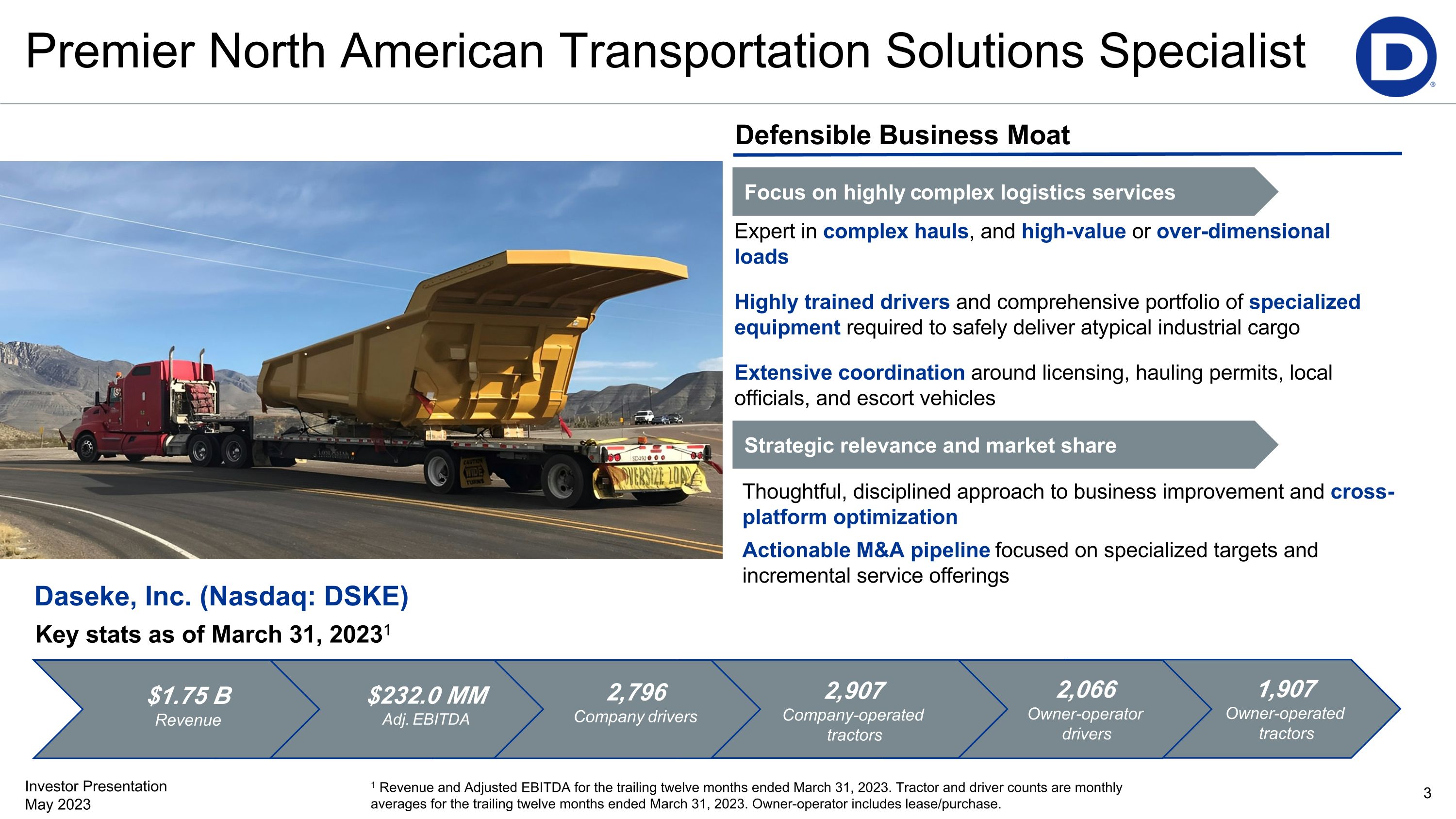
Premier North American Transportation Solutions Specialist Defensible Business Moat Expert in complex hauls, and high-value or over-dimensional loads Highly trained drivers and comprehensive portfolio of specialized equipment required to safely deliver atypical industrial cargo Extensive coordination around licensing, hauling permits, local officials, and escort vehicles Thoughtful, disciplined approach to business improvement and cross-platform optimization Actionable M&A pipeline focused on specialized targets and incremental service offerings Strategic relevance and market share Focus on highly complex logistics services 2,066 Owner-operator drivers $1.75 B Revenue $232.0 MM Adj. EBITDA 2,907 Company-operated tractors 2,796 Company drivers 1,907 Owner-operated tractors Key stats as of March 31, 20231 1 Revenue and Adjusted EBITDA for the trailing twelve months ended March 31, 2023. Tractor and driver counts are monthly averages for the trailing twelve months ended March 31, 2023. Owner-operator includes lease/purchase. Daseke, Inc. (Nasdaq: DSKE)
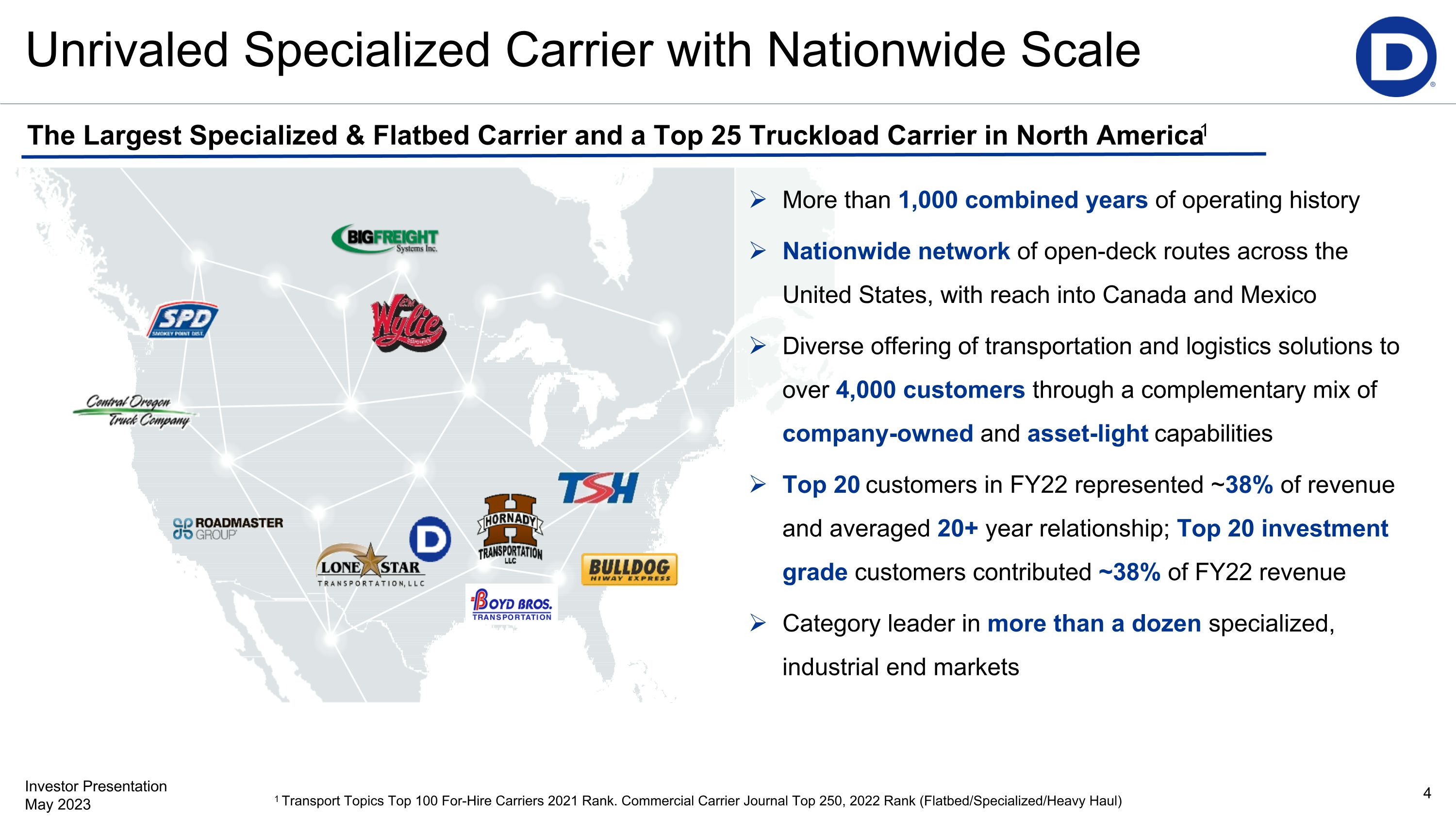
a Unrivaled Specialized Carrier with Nationwide Scale 1 Transport Topics Top 100 For-Hire Carriers 2021 Rank. Commercial Carrier Journal Top 250, 2022 Rank (Flatbed/Specialized/Heavy Haul) More than 1,000 combined years of operating history Nationwide network of open-deck routes across the United States, with reach into Canada and Mexico Diverse offering of transportation and logistics solutions to over 4,000 customers through a complementary mix of company-owned and asset-light capabilities Top 20 customers in FY22 represented ~38% of revenue and averaged 20+ year relationship; Top 20 investment grade customers contributed ~38% of FY22 revenue Category leader in more than a dozen specialized, industrial end markets The Largest Specialized & Flatbed Carrier and a Top 25 Truckload Carrier in North America1
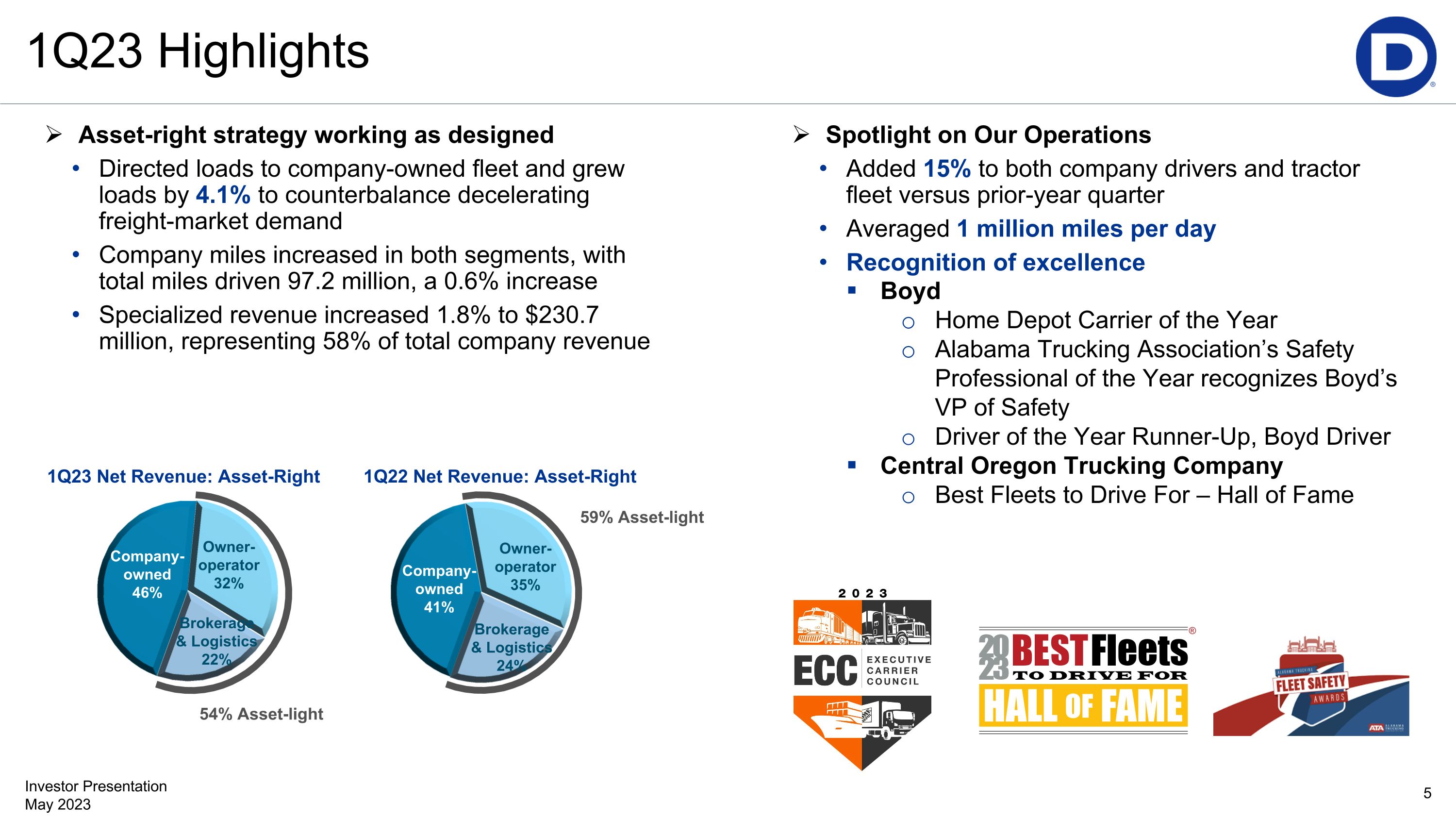
1Q23 Highlights Asset-right strategy working as designed Directed loads to company-owned fleet and grew loads by 4.1% to counterbalance decelerating freight-market demand Company miles increased in both segments, with total miles driven 97.2 million, a 0.6% increase Specialized revenue increased 1.8% to $230.7 million, representing 58% of total company revenue 1Q23 Net Revenue: Asset-Right 54% Asset-light 1Q22 Net Revenue: Asset-Right 59% Asset-light Spotlight on Our Operations Added 15% to both company drivers and tractor fleet versus prior-year quarter Averaged 1 million miles per day Recognition of excellence Boyd Home Depot Carrier of the Year Alabama Trucking Association’s Safety Professional of the Year recognizes Boyd’s VP of Safety Driver of the Year Runner-Up, Boyd Driver Central Oregon Trucking Company Best Fleets to Drive For – Hall of Fame
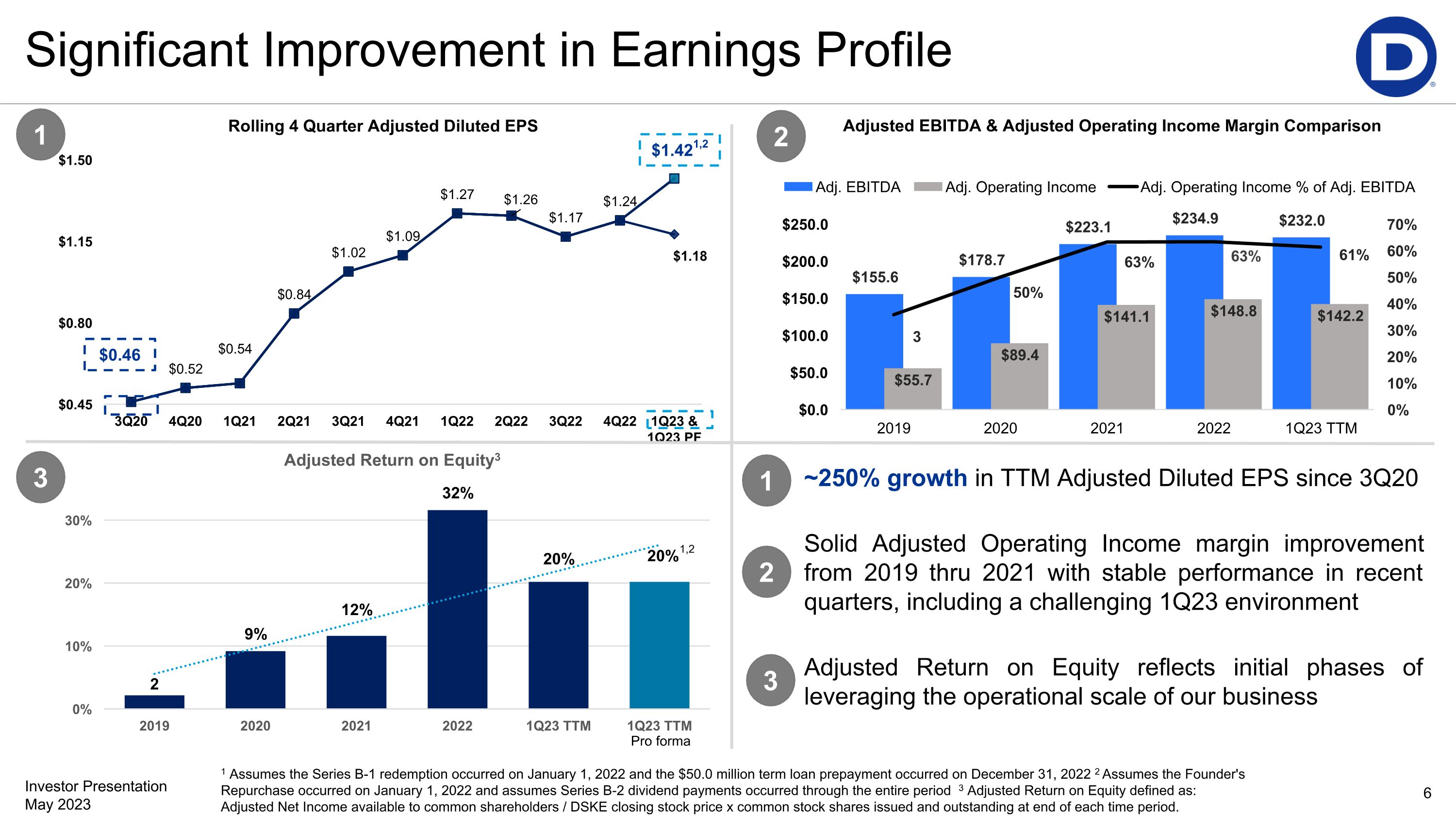
Significant Improvement in Earnings Profile 1 Assumes the Series B-1 redemption occurred on January 1, 2022 and the $50.0 million term loan prepayment occurred on December 31, 2022 2 Assumes the Founder's Repurchase occurred on January 1, 2022 and assumes Series B-2 dividend payments occurred through the entire period 3 Adjusted Return on Equity defined as: Adjusted Net Income available to common shareholders / DSKE closing stock price x common stock shares issued and outstanding at end of each time period. ~250% growth in TTM Adjusted Diluted EPS since 3Q20 Solid Adjusted Operating Income margin improvement from 2019 thru 2021 with stable performance in recent quarters, including a challenging 1Q23 environment Adjusted Return on Equity reflects initial phases of leveraging the operational scale of our business $1.421,2 1 3 2 Adjusted EBITDA & Adjusted Operating Income Margin Comparison 1 2 3 1,2 Pro forma $0.46
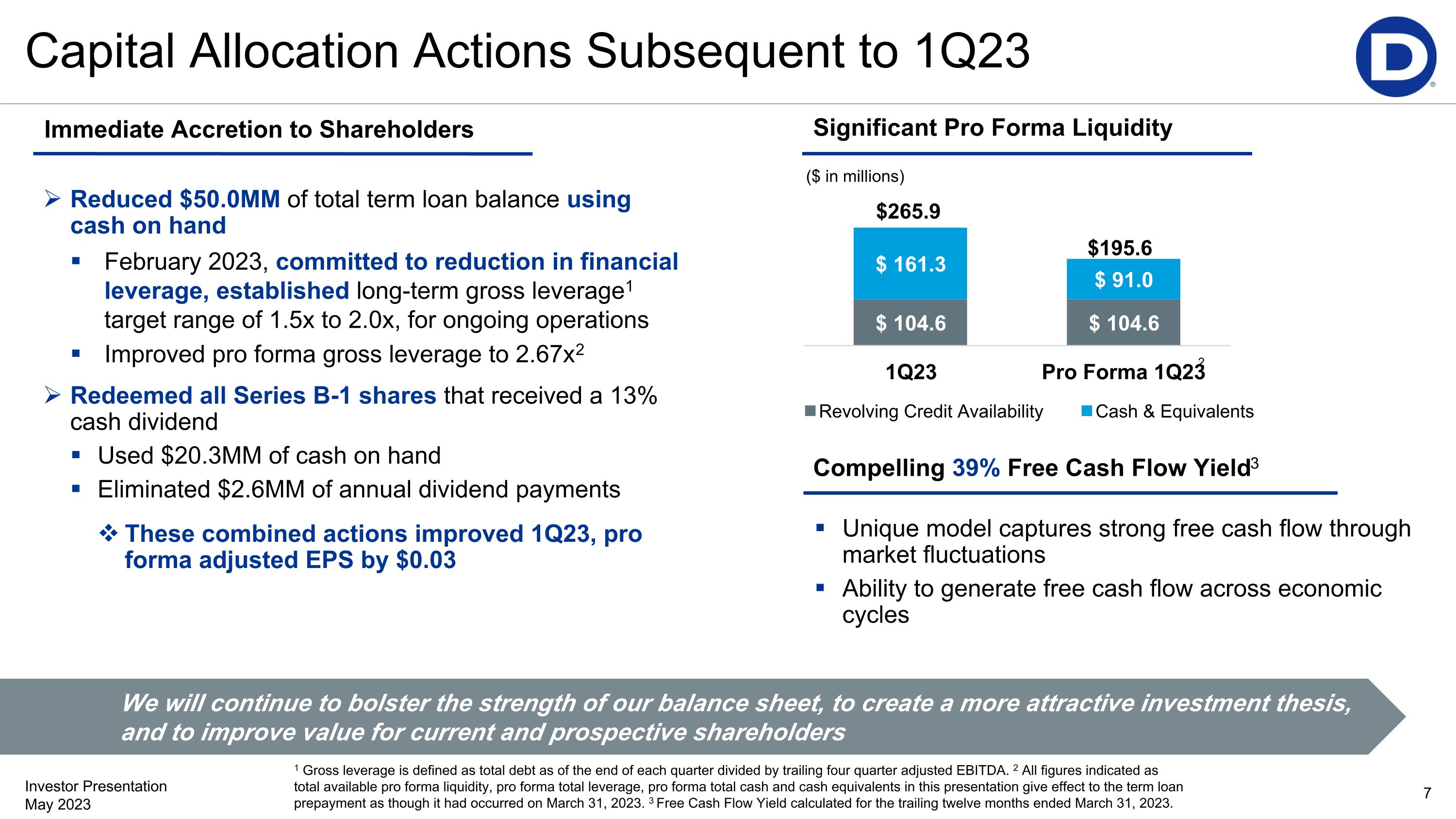
Capital Allocation Actions Subsequent to 1Q23 1 Gross leverage is defined as total debt as of the end of each quarter divided by trailing four quarter adjusted EBITDA. 2 All figures indicated as total available pro forma liquidity, pro forma total leverage, pro forma total cash and cash equivalents in this presentation give effect to the term loan prepayment as though it had occurred on March 31, 2023. 3 Free Cash Flow Yield calculated for the trailing twelve months ended March 31, 2023. Reduced $50.0MM of total term loan balance using cash on hand February 2023, committed to reduction in financial leverage, established long-term gross leverage1 target range of 1.5x to 2.0x, for ongoing operations Improved pro forma gross leverage to 2.67x2 Redeemed all Series B-1 shares that received a 13% cash dividend Used $20.3MM of cash on hand Eliminated $2.6MM of annual dividend payments These combined actions improved 1Q23, pro forma adjusted EPS by $0.03 Immediate Accretion to Shareholders $265.9 $195.6 Significant Pro Forma Liquidity We will continue to bolster the strength of our balance sheet, to create a more attractive investment thesis, and to improve value for current and prospective shareholders Unique model captures strong free cash flow through market fluctuations Ability to generate free cash flow across economic cycles Compelling 39% Free Cash Flow Yield3 2
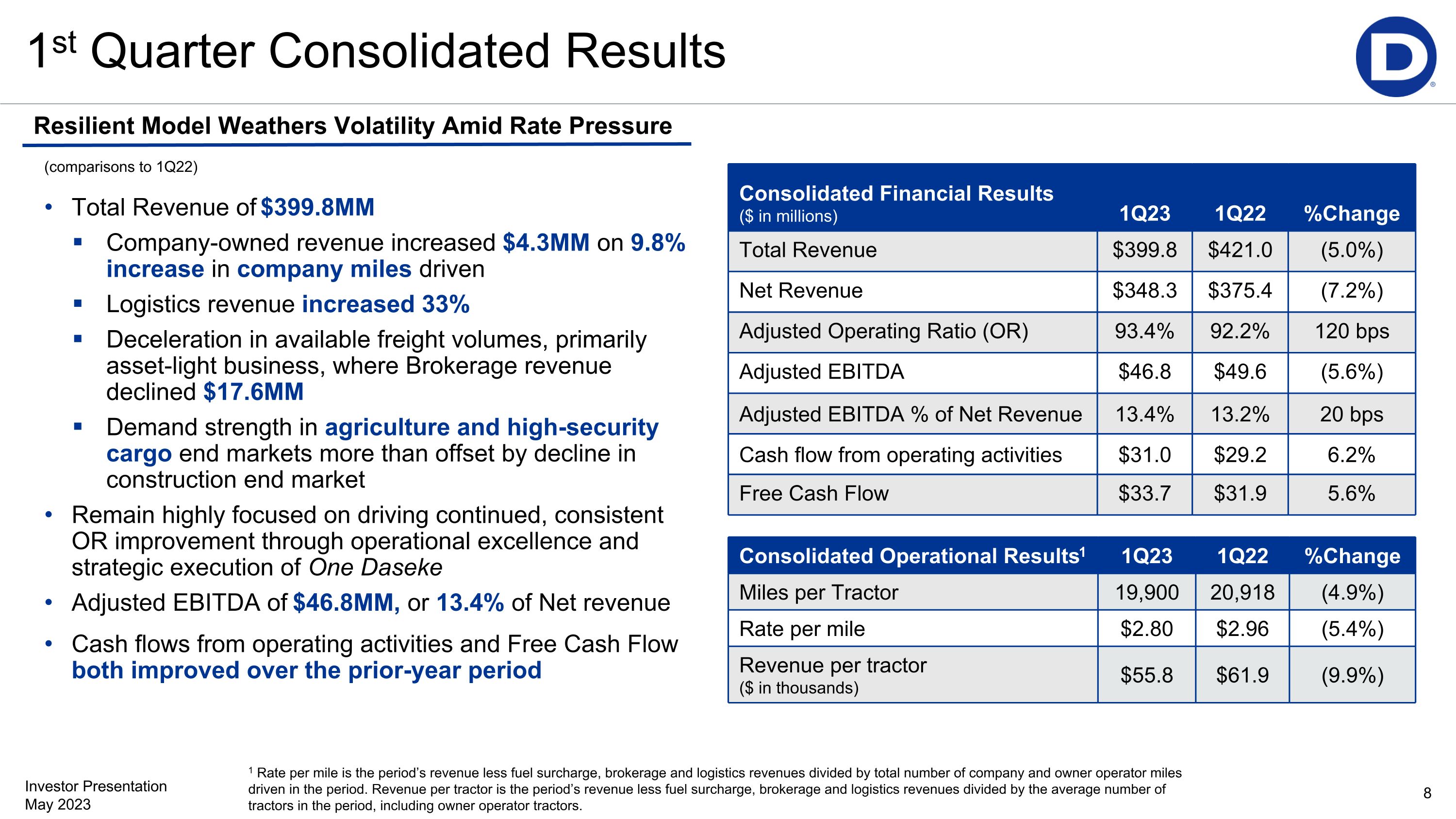
1st Quarter Consolidated Results Consolidated Financial Results ($ in millions) 1Q23 1Q22 %Change Total Revenue $399.8 $421.0 (5.0%) Net Revenue $348.3 $375.4 (7.2%) Adjusted Operating Ratio (OR) 93.4% 92.2% 120 bps Adjusted EBITDA $46.8 $49.6 (5.6%) Adjusted EBITDA % of Net Revenue 13.4% 13.2% 20 bps Cash flow from operating activities $31.0 $29.2 6.2% Free Cash Flow $33.7 $31.9 5.6% (comparisons to 1Q22) Total Revenue of $399.8MM Company-owned revenue increased $4.3MM on 9.8% increase in company miles driven Logistics revenue increased 33% Deceleration in available freight volumes, primarily asset-light business, where Brokerage revenue declined $17.6MM Demand strength in agriculture and high-security cargo end markets more than offset by decline in construction end market Remain highly focused on driving continued, consistent OR improvement through operational excellence and strategic execution of One Daseke Adjusted EBITDA of $46.8MM, or 13.4% of Net revenue Cash flows from operating activities and Free Cash Flow both improved over the prior-year period Resilient Model Weathers Volatility Amid Rate Pressure Consolidated Operational Results1 1Q23 1Q22 %Change Miles per Tractor 19,900 20,918 (4.9%) Rate per mile $2.80 $2.96 (5.4%) Revenue per tractor ($ in thousands) $55.8 $61.9 (9.9%) 1 Rate per mile is the period’s revenue less fuel surcharge, brokerage and logistics revenues divided by total number of company and owner operator miles driven in the period. Revenue per tractor is the period’s revenue less fuel surcharge, brokerage and logistics revenues divided by the average number of tractors in the period, including owner operator tractors.
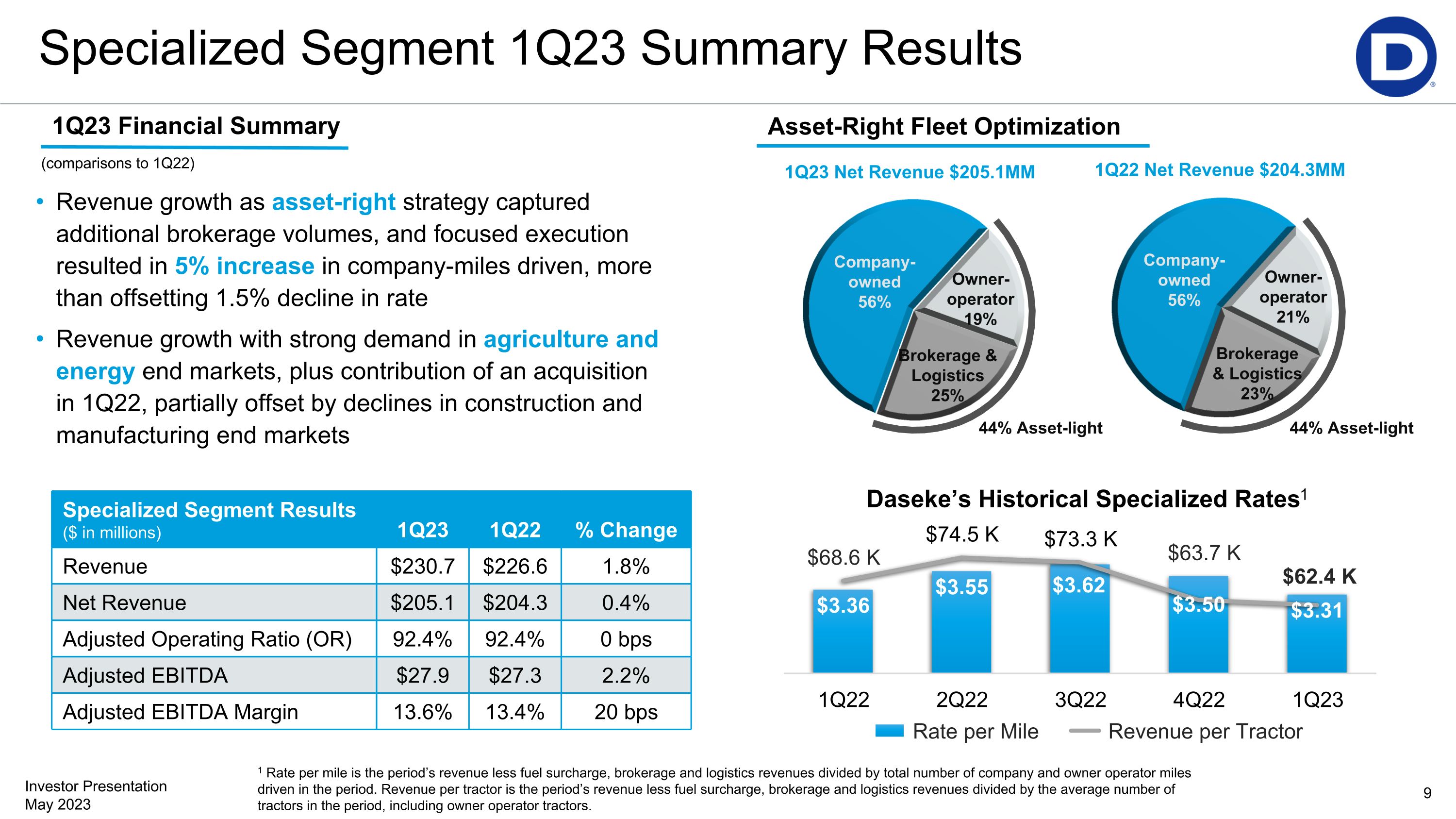
1Q23 Financial Summary Specialized Segment 1Q23 Summary Results Revenue growth as asset-right strategy captured additional brokerage volumes, and focused execution resulted in 5% increase in company-miles driven, more than offsetting 1.5% decline in rate Revenue growth with strong demand in agriculture and energy end markets, plus contribution of an acquisition in 1Q22, partially offset by declines in construction and manufacturing end markets Specialized Segment Results ($ in millions) 1Q23 1Q22 % Change Revenue $230.7 $226.6 1.8% Net Revenue $205.1 $204.3 0.4% Adjusted Operating Ratio (OR) 92.4% 92.4% 0 bps Adjusted EBITDA $27.9 $27.3 2.2% Adjusted EBITDA Margin 13.6% 13.4% 20 bps 1Q22 Net Revenue $204.3MM 44% Asset-light 1Q23 Net Revenue $205.1MM 44% Asset-light Asset-Right Fleet Optimization (comparisons to 1Q22) 1 Rate per mile is the period’s revenue less fuel surcharge, brokerage and logistics revenues divided by total number of company and owner operator miles driven in the period. Revenue per tractor is the period’s revenue less fuel surcharge, brokerage and logistics revenues divided by the average number of tractors in the period, including owner operator tractors.
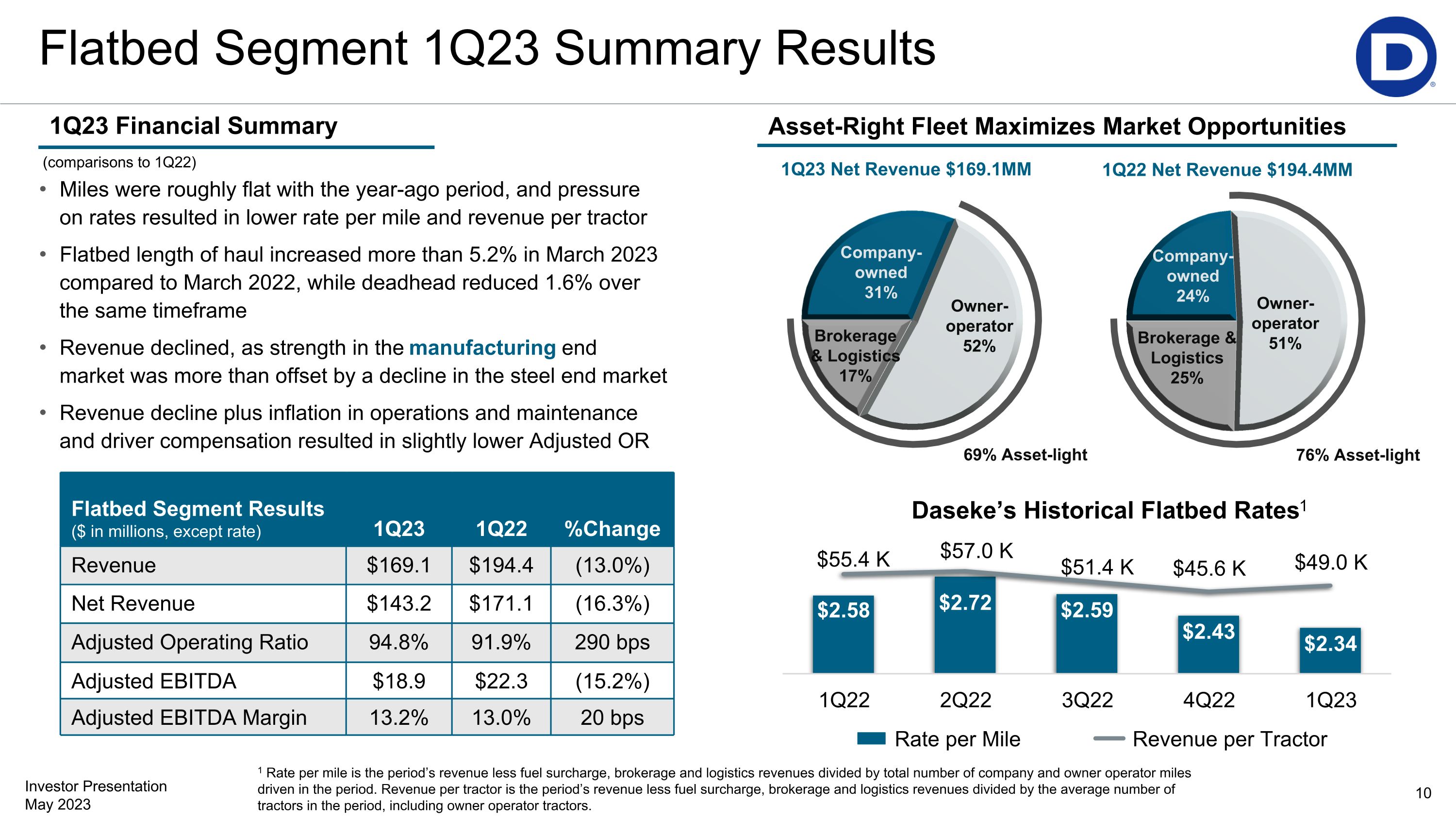
Flatbed Segment 1Q23 Summary Results 1Q23 Financial Summary Miles were roughly flat with the year-ago period, and pressure on rates resulted in lower rate per mile and revenue per tractor Flatbed length of haul increased more than 5.2% in March 2023 compared to March 2022, while deadhead reduced 1.6% over the same timeframe Revenue declined, as strength in the manufacturing end market was more than offset by a decline in the steel end market Revenue decline plus inflation in operations and maintenance and driver compensation resulted in slightly lower Adjusted OR Flatbed Segment Results ($ in millions, except rate) 1Q23 1Q22 %Change Revenue $169.1 $194.4 (13.0%) Net Revenue $143.2 $171.1 (16.3%) Adjusted Operating Ratio 94.8% 91.9% 290 bps Adjusted EBITDA $18.9 $22.3 (15.2%) Adjusted EBITDA Margin 13.2% 13.0% 20 bps 1Q23 Net Revenue $169.1MM 1Q22 Net Revenue $194.4MM 69% Asset-light 76% Asset-light Asset-Right Fleet Maximizes Market Opportunities (comparisons to 1Q22) 1 Rate per mile is the period’s revenue less fuel surcharge, brokerage and logistics revenues divided by total number of company and owner operator miles driven in the period. Revenue per tractor is the period’s revenue less fuel surcharge, brokerage and logistics revenues divided by the average number of tractors in the period, including owner operator tractors.
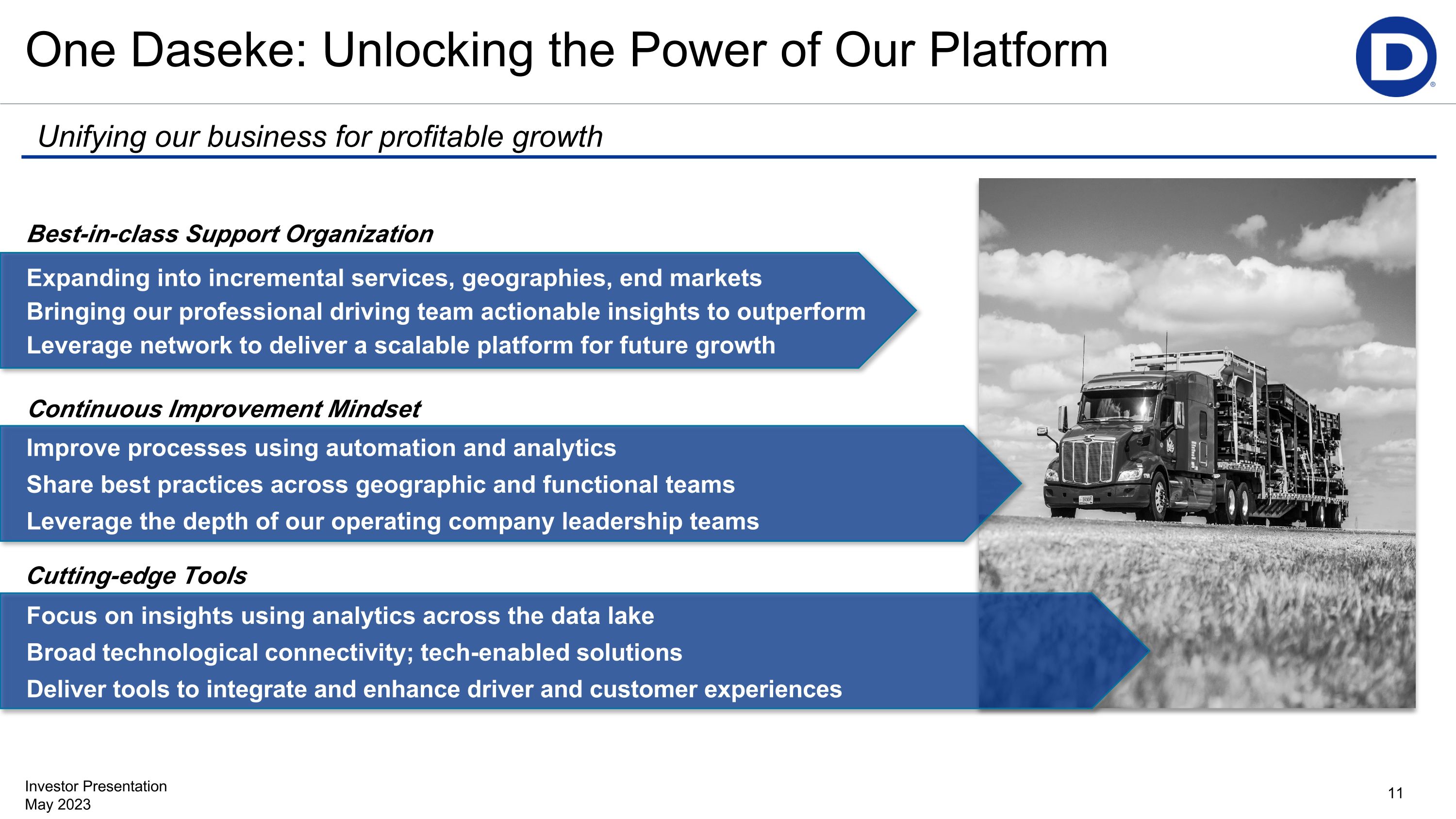
One Daseke: Unlocking the Power of Our Platform Unifying our business for profitable growth Expanding into incremental services, geographies, end markets Bringing our professional driving team actionable insights to outperform Leverage network to deliver a scalable platform for future growth Best-in-class Support Organization Cutting-edge Tools Focus on insights using analytics across the data lake Broad technological connectivity; tech-enabled solutions Deliver tools to integrate and enhance driver and customer experiences Continuous Improvement Mindset Improve processes using automation and analytics Share best practices across geographic and functional teams Leverage the depth of our operating company leadership teams
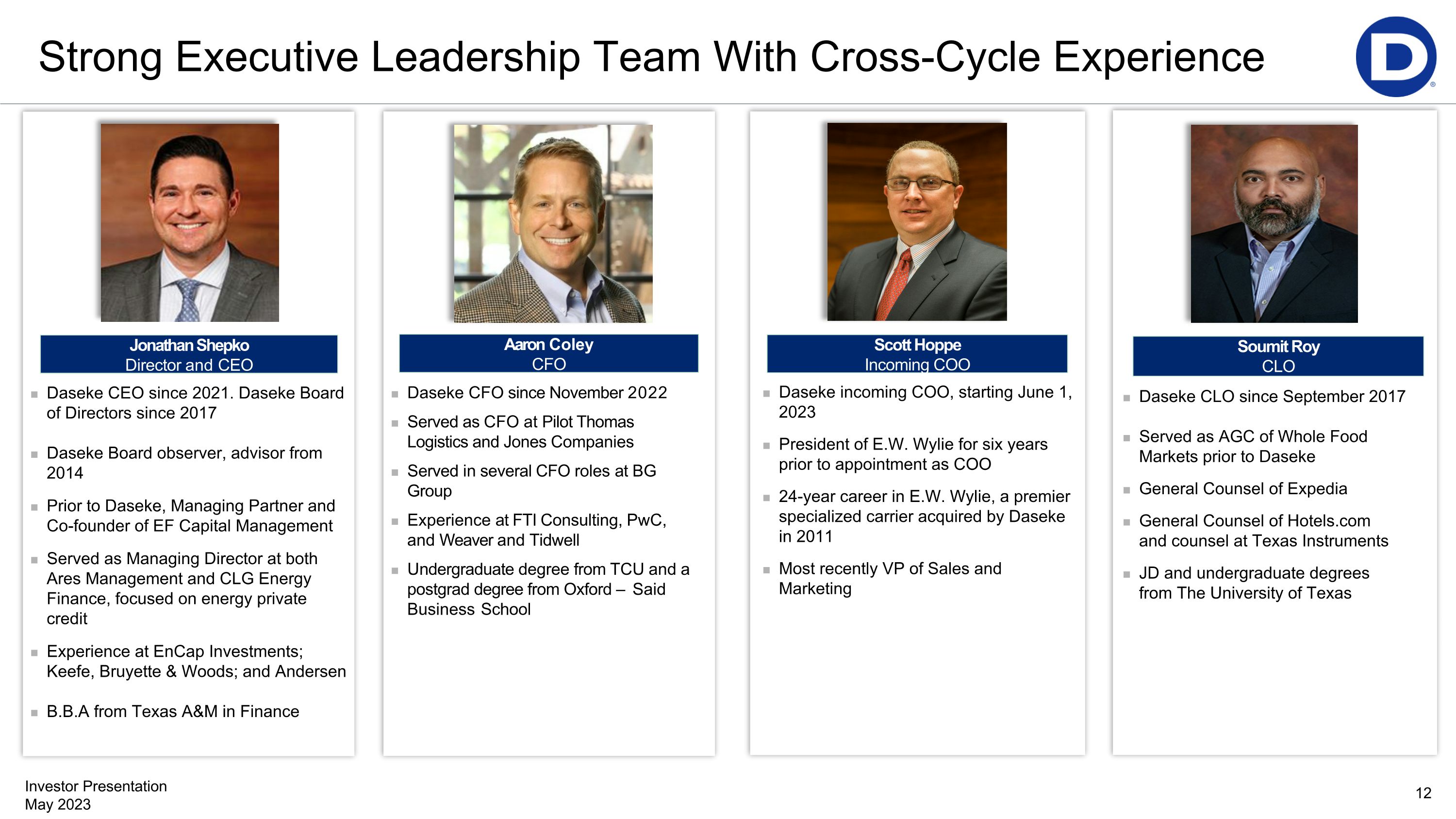
Strong Executive Leadership Team With Cross-Cycle Experience Soumit Roy CLO Jonathan Shepko Director and CEO Daseke CEO since 2021. Daseke Board of Directors since 2017 Daseke Board observer, advisor from 2014 Prior to Daseke, Managing Partner and Co-founder of EF Capital Management Served as Managing Director at both Ares Management and CLG Energy Finance, focused on energy private credit Experience at EnCap Investments; Keefe, Bruyette & Woods; and Andersen B.B.A from Texas A&M in Finance Scott Hoppe Incoming COO Daseke incoming COO, starting June 1, 2023 President of E.W. Wylie for six years prior to appointment as COO 24-year career in E.W. Wylie, a premier specialized carrier acquired by Daseke in 2011 Most recently VP of Sales and Marketing Daseke CLO since September 2017 Served as AGC of Whole Food Markets prior to Daseke General Counsel of Expedia General Counsel of Hotels.com and counsel at Texas Instruments JD and undergraduate degrees from The University of Texas Daseke CFO since November 2022 Served as CFO at Pilot Thomas Logistics and Jones Companies Served in several CFO roles at BG Group Experience at FTI Consulting, PwC, and Weaver and Tidwell Undergraduate degree from TCU and a postgrad degree from Oxford – Said Business School Aaron Coley CFO
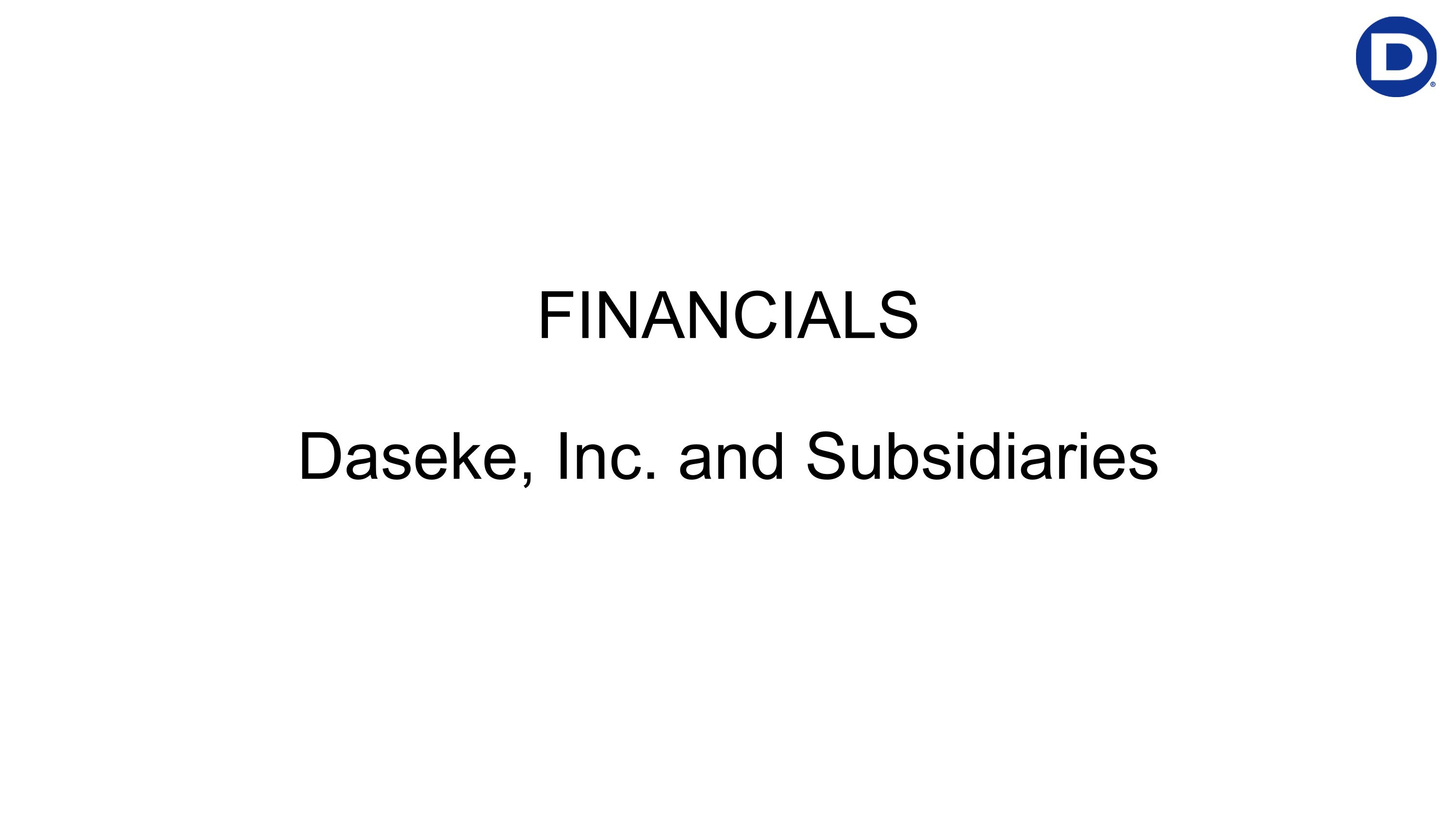
FINANCIALS��Daseke, Inc. and Subsidiaries
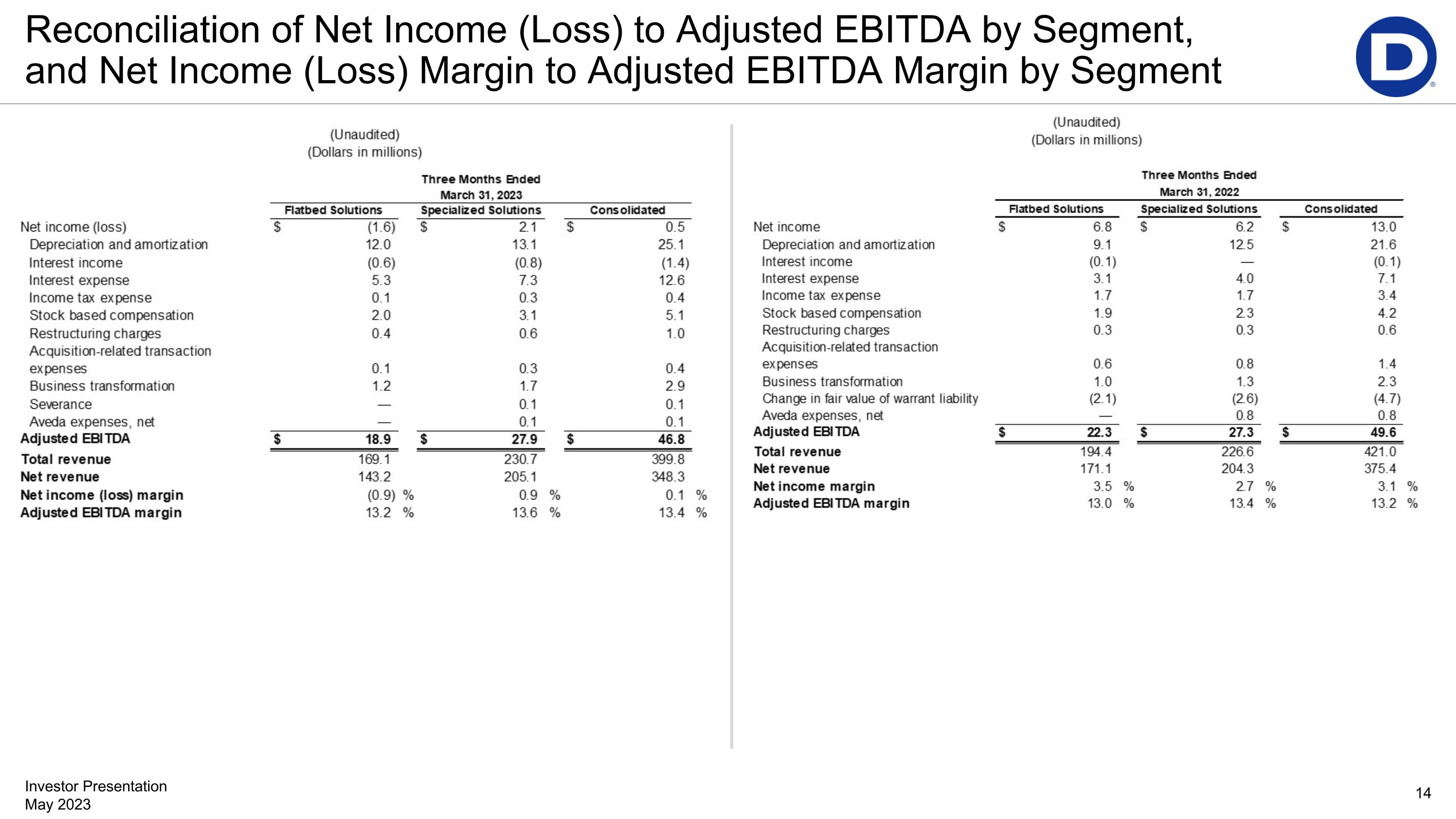
Reconciliation of Net Income (Loss) to Adjusted EBITDA by Segment, and Net Income (Loss) Margin to Adjusted EBITDA Margin by Segment
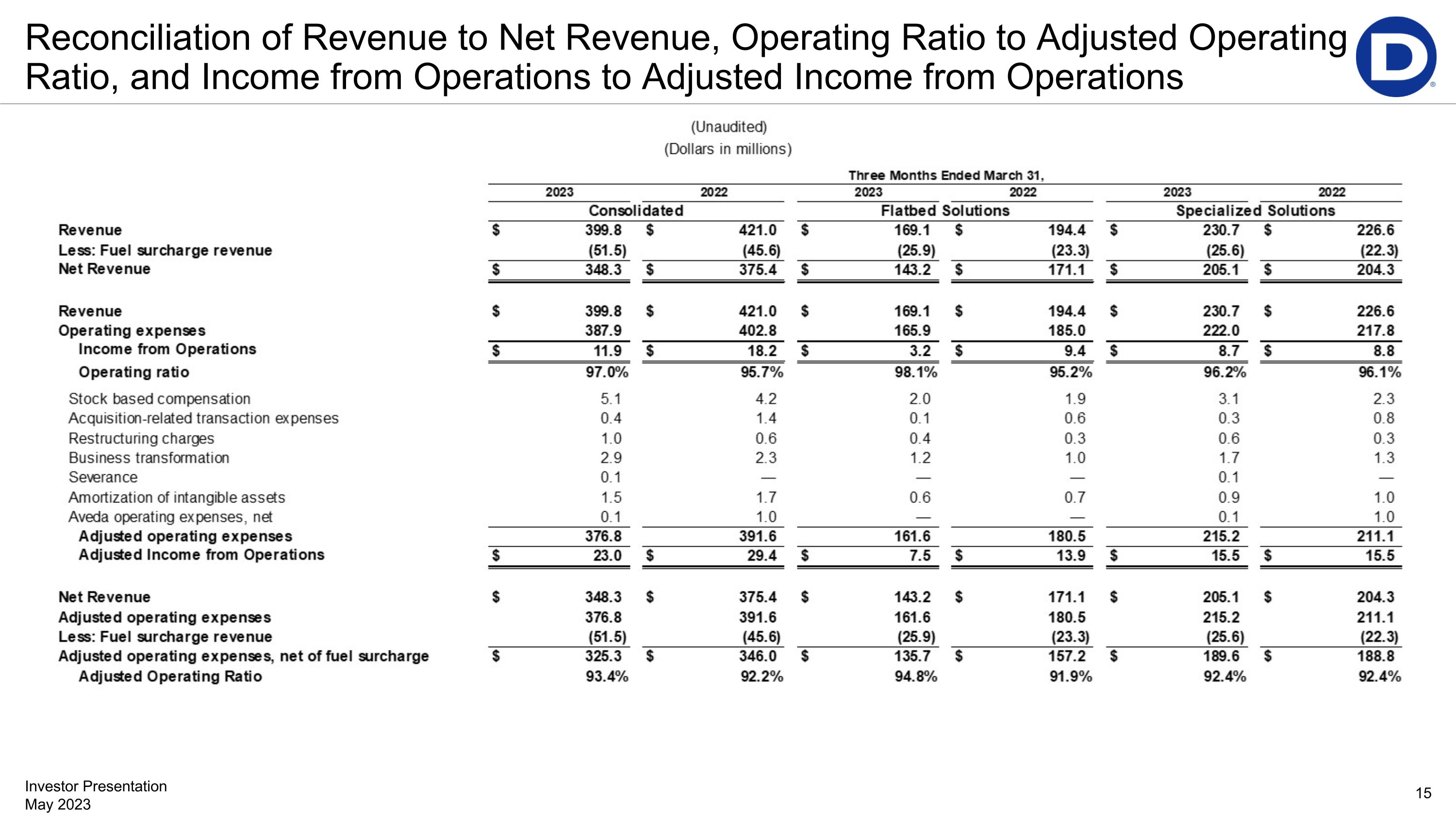
Reconciliation of Revenue to Net Revenue, Operating Ratio to Adjusted Operating Ratio, and Income from Operations to Adjusted Income from Operations
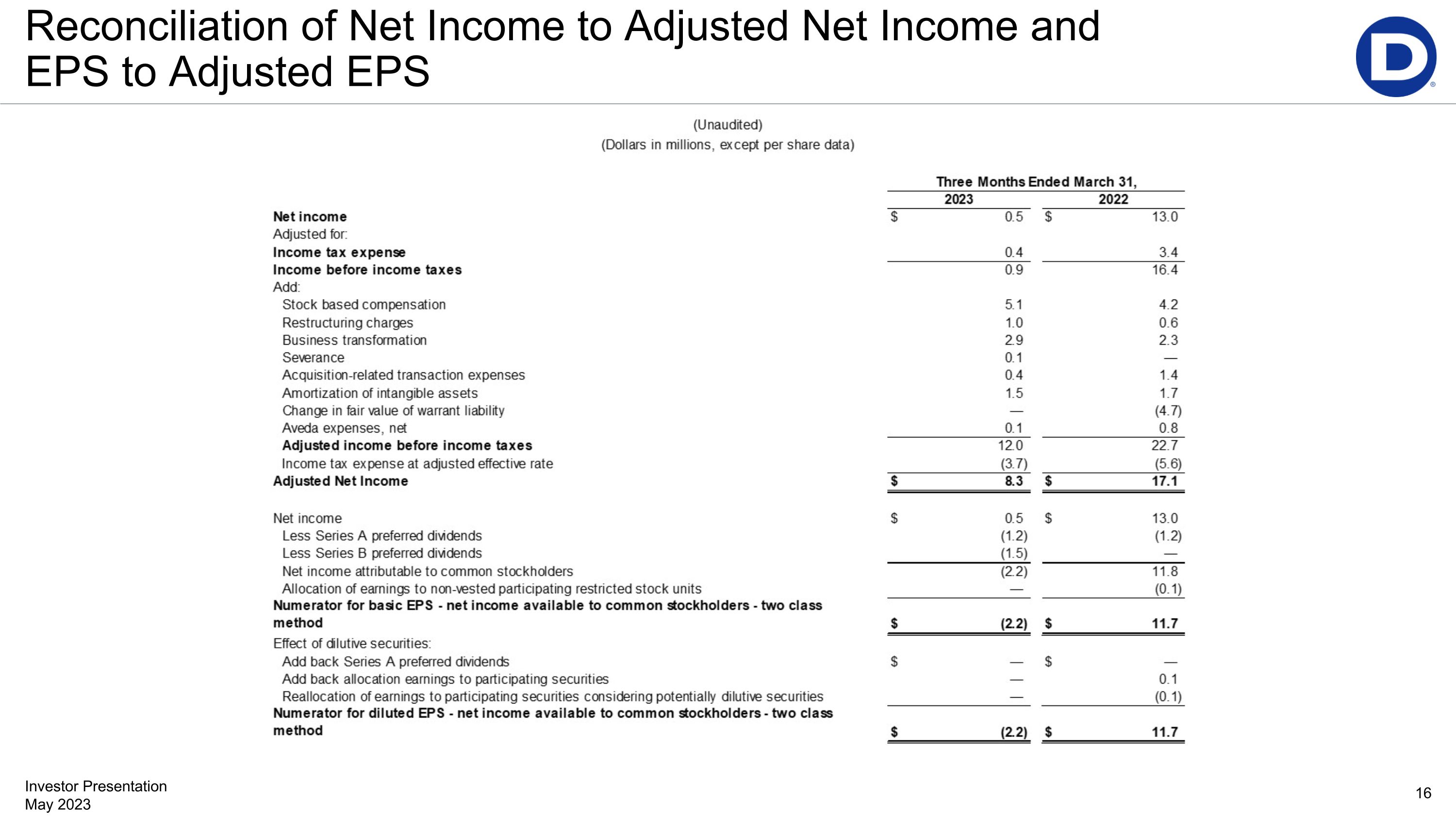
Reconciliation of Net Income to Adjusted Net Income and �EPS to Adjusted EPS
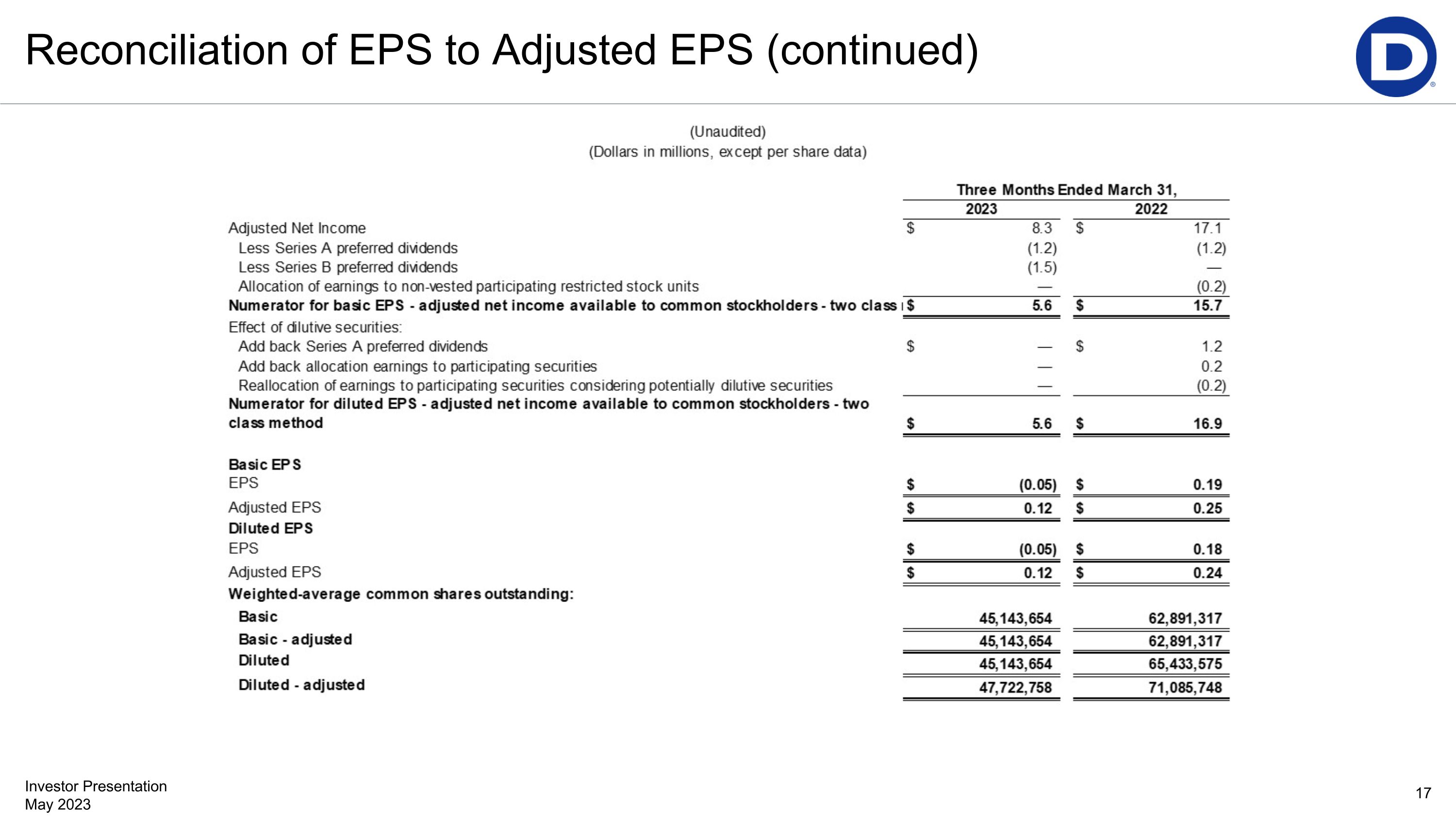
Reconciliation of EPS to Adjusted EPS (continued)
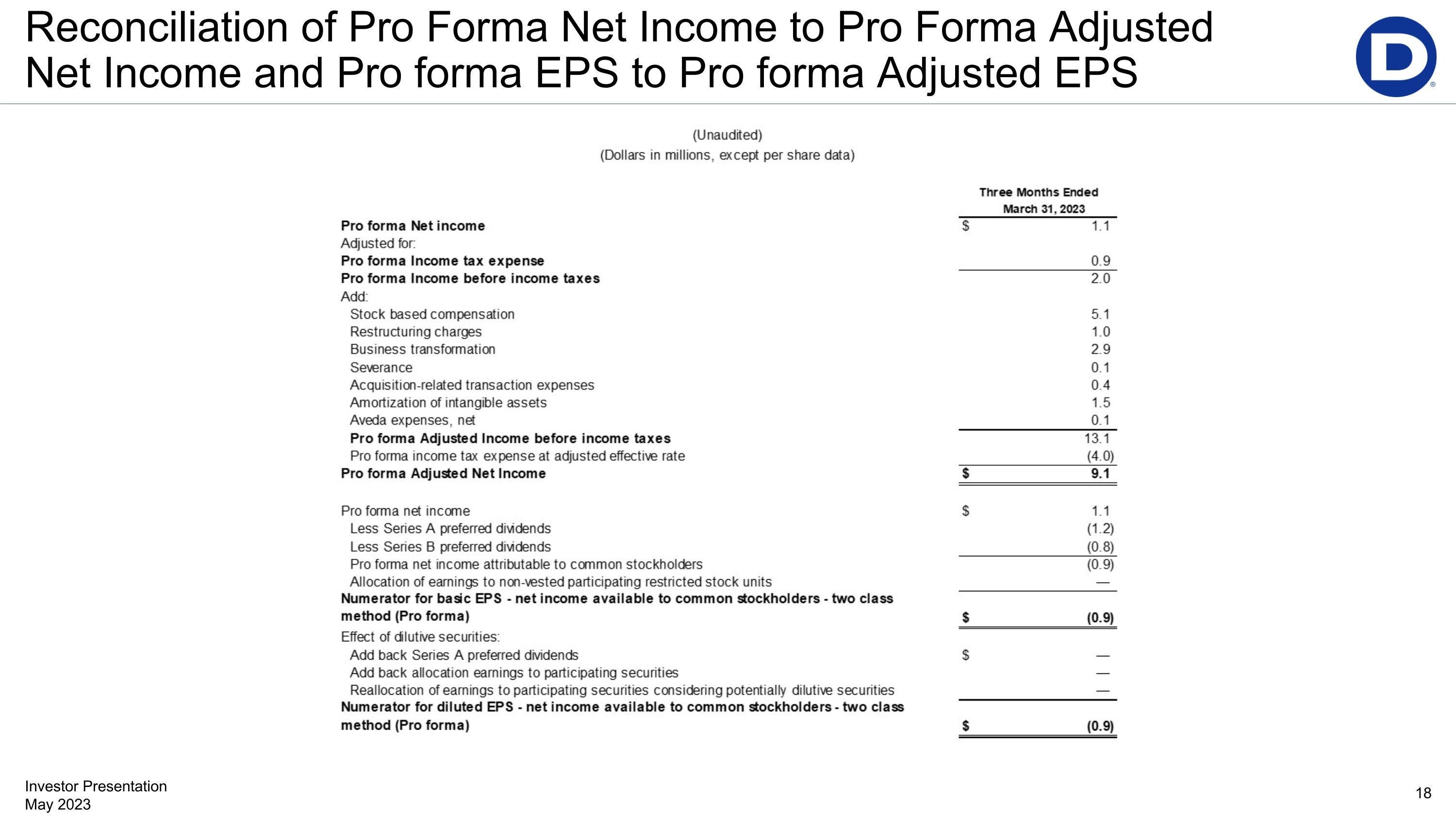
Reconciliation of Pro Forma Net Income to Pro Forma Adjusted �Net Income and Pro forma EPS to Pro forma Adjusted EPS
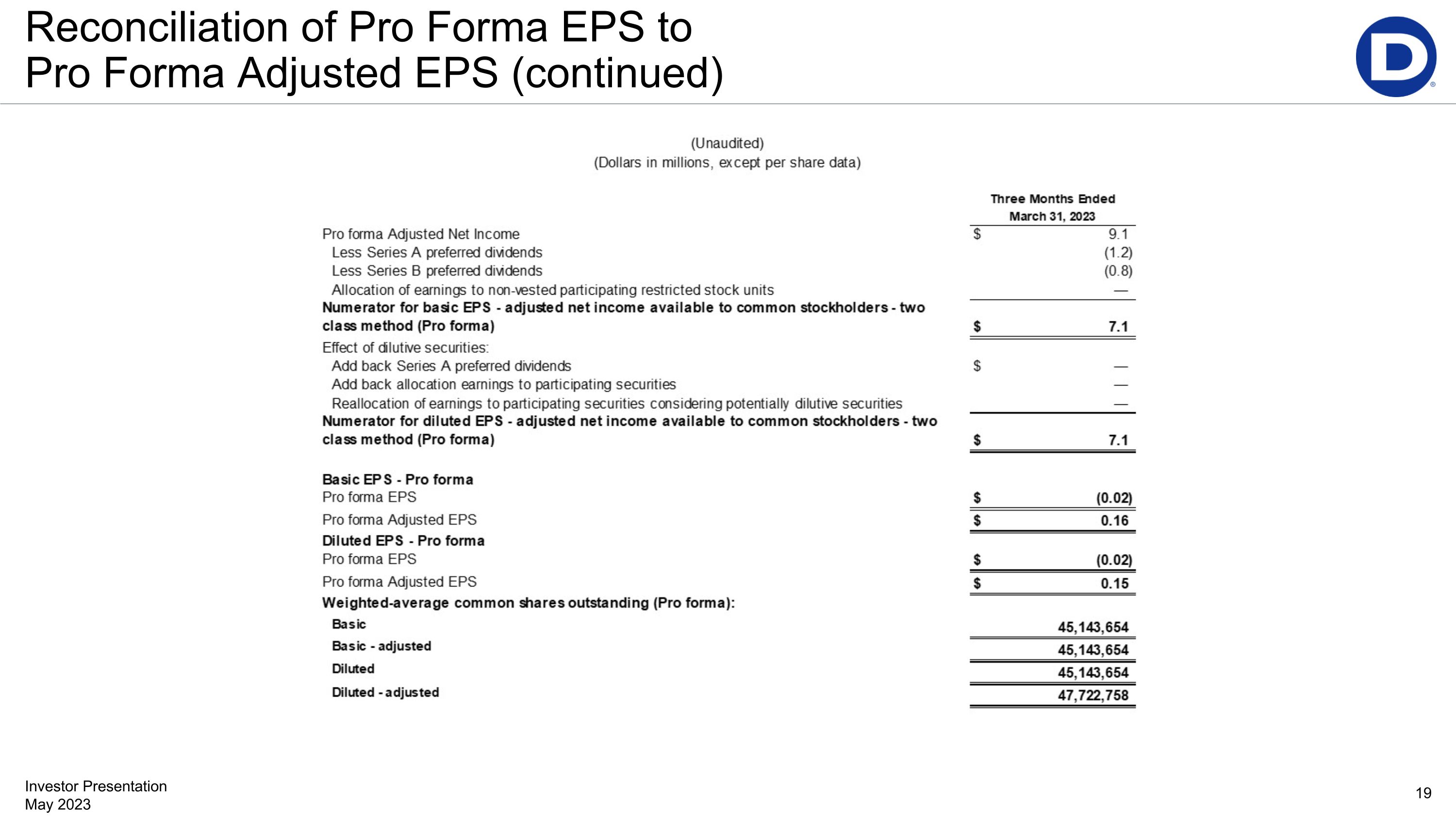
Reconciliation of Pro Forma EPS to �Pro Forma Adjusted EPS (continued)
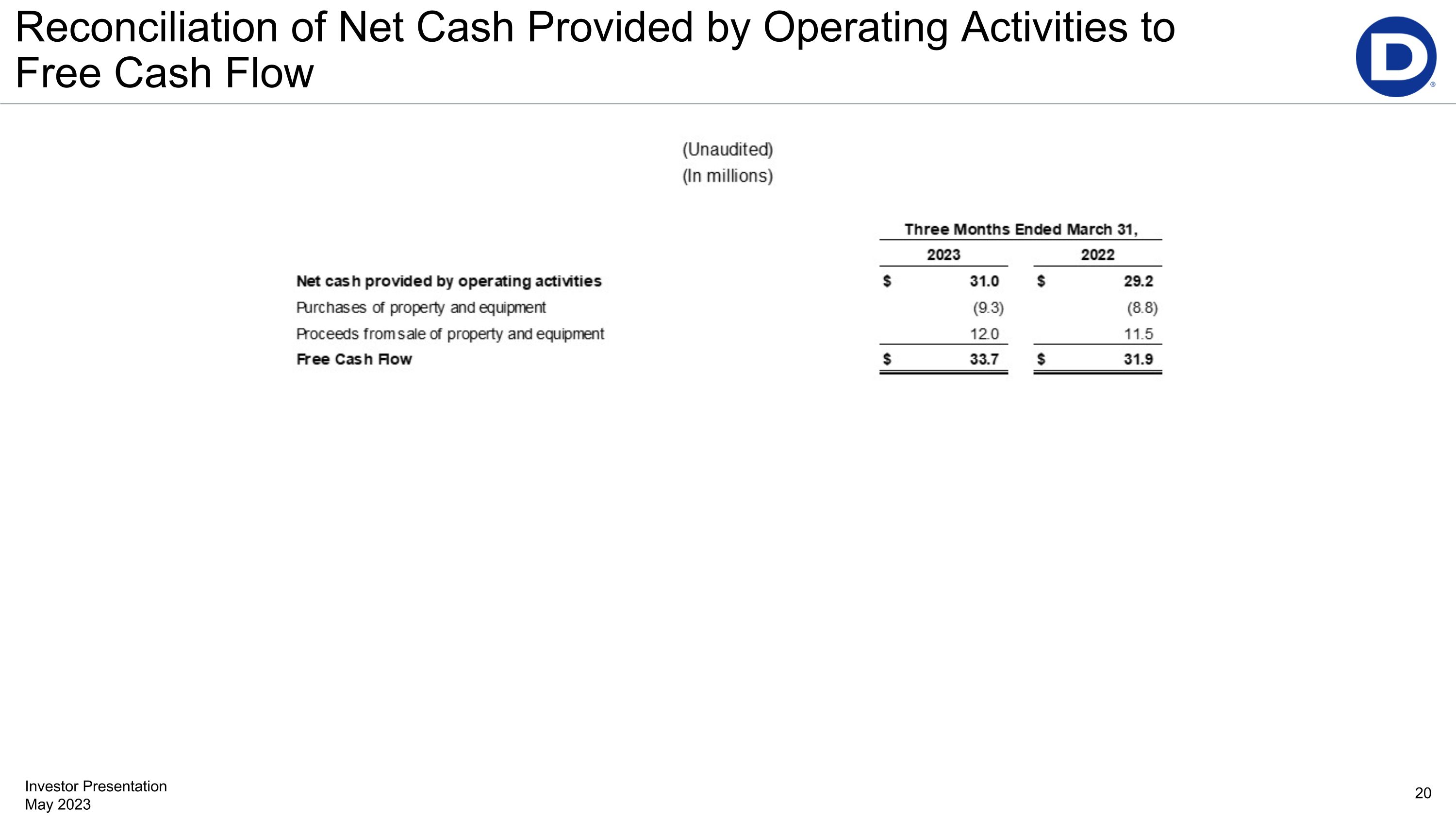
Reconciliation of Net Cash Provided by Operating Activities to �Free Cash Flow
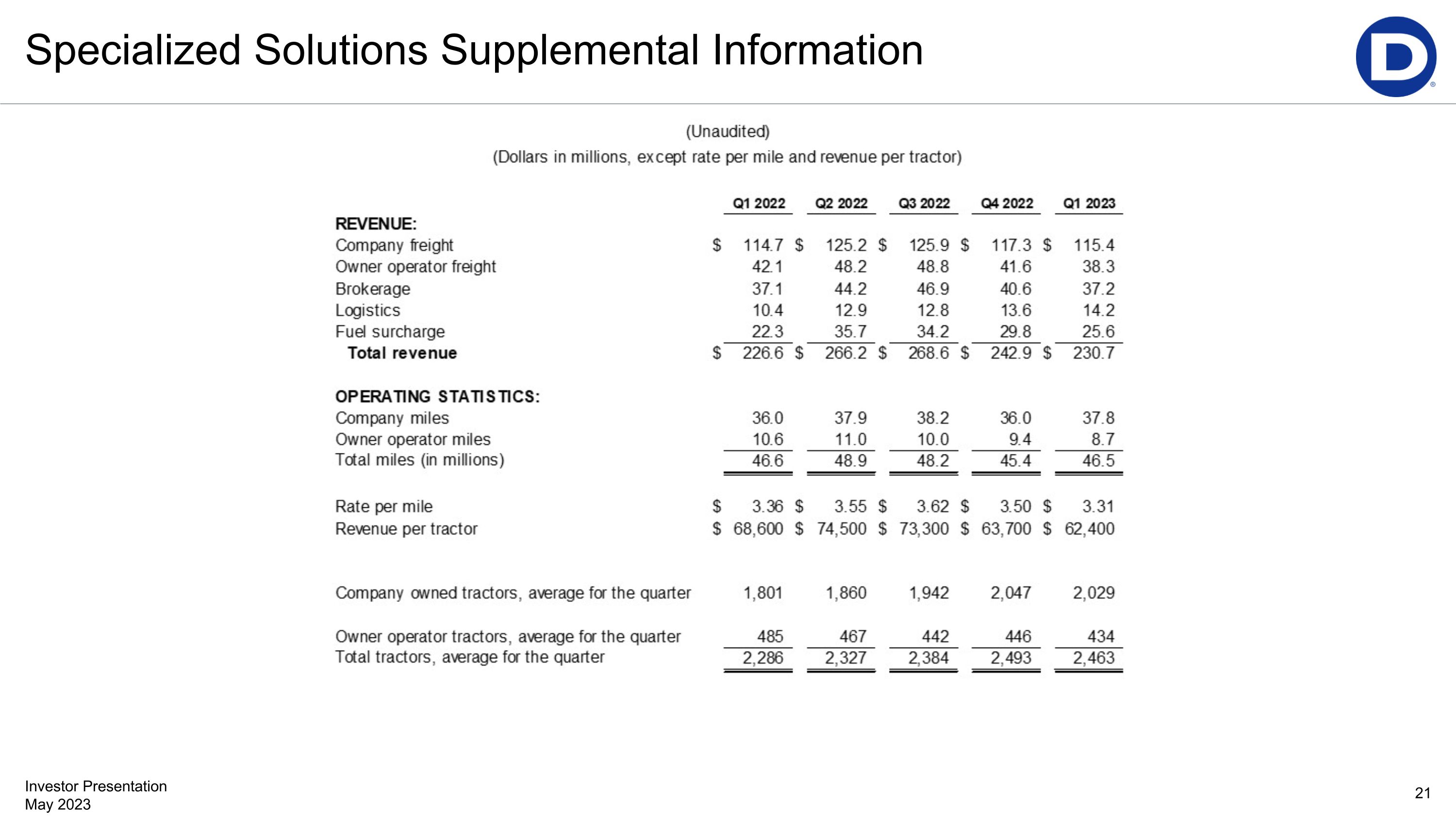
Specialized Solutions Supplemental Information
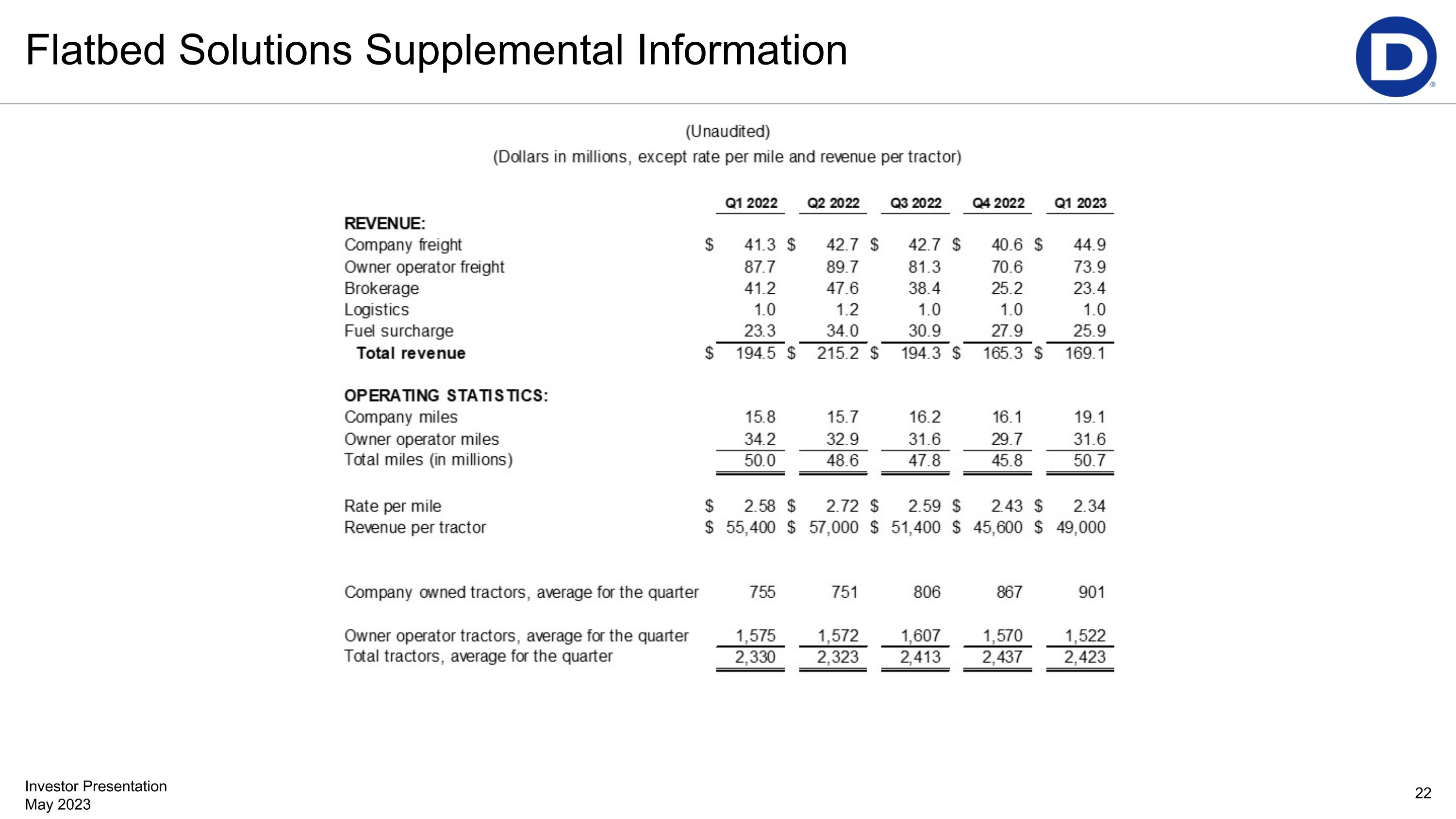
Flatbed Solutions Supplemental Information
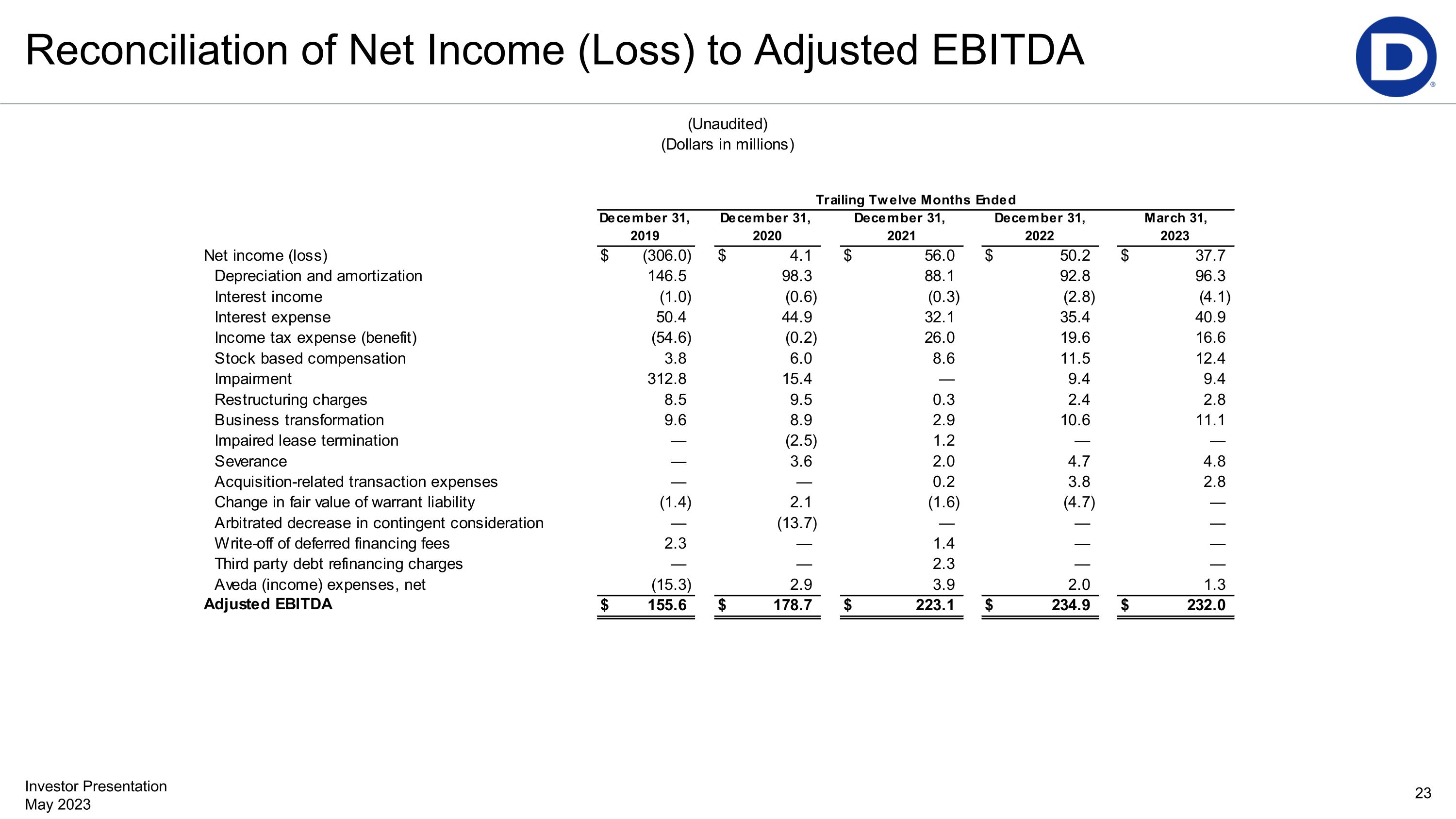
Reconciliation of Net Income (Loss) to Adjusted EBITDA
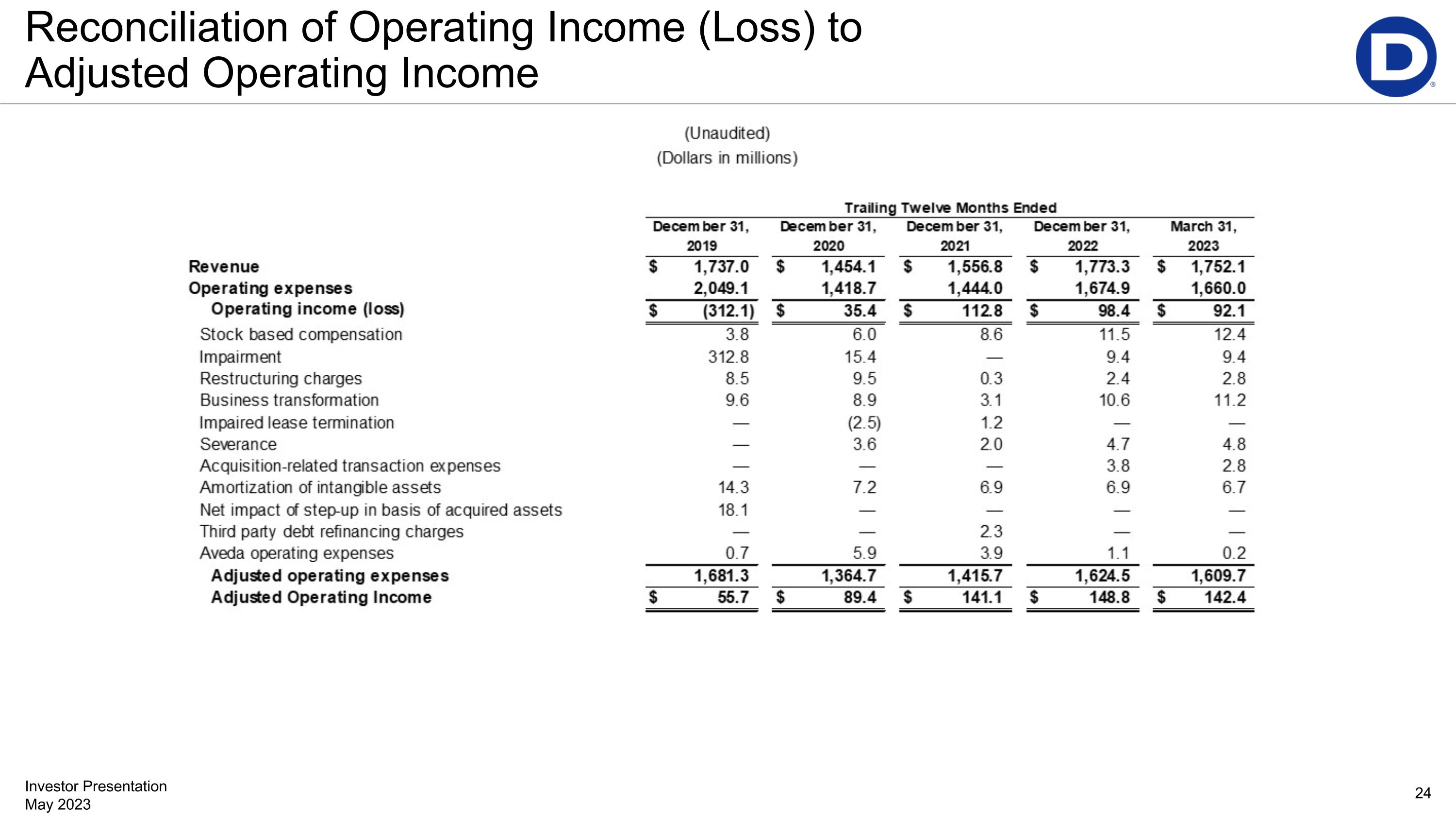
Reconciliation of Operating Income (Loss) to �Adjusted Operating Income
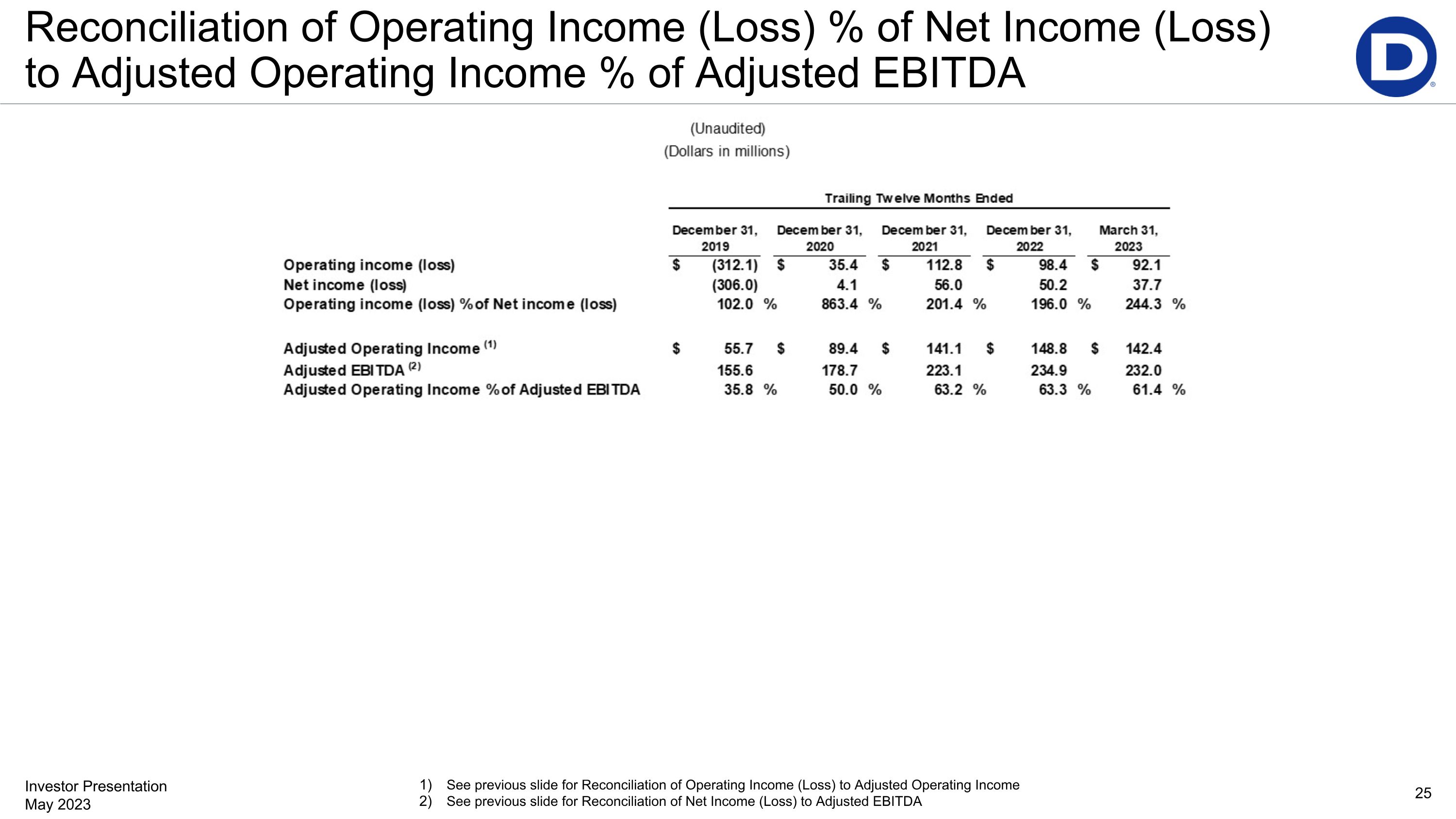
Reconciliation of Operating Income (Loss) % of Net Income (Loss) to Adjusted Operating Income % of Adjusted EBITDA See previous slide for Reconciliation of Operating Income (Loss) to Adjusted Operating Income See previous slide for Reconciliation of Net Income (Loss) to Adjusted EBITDA
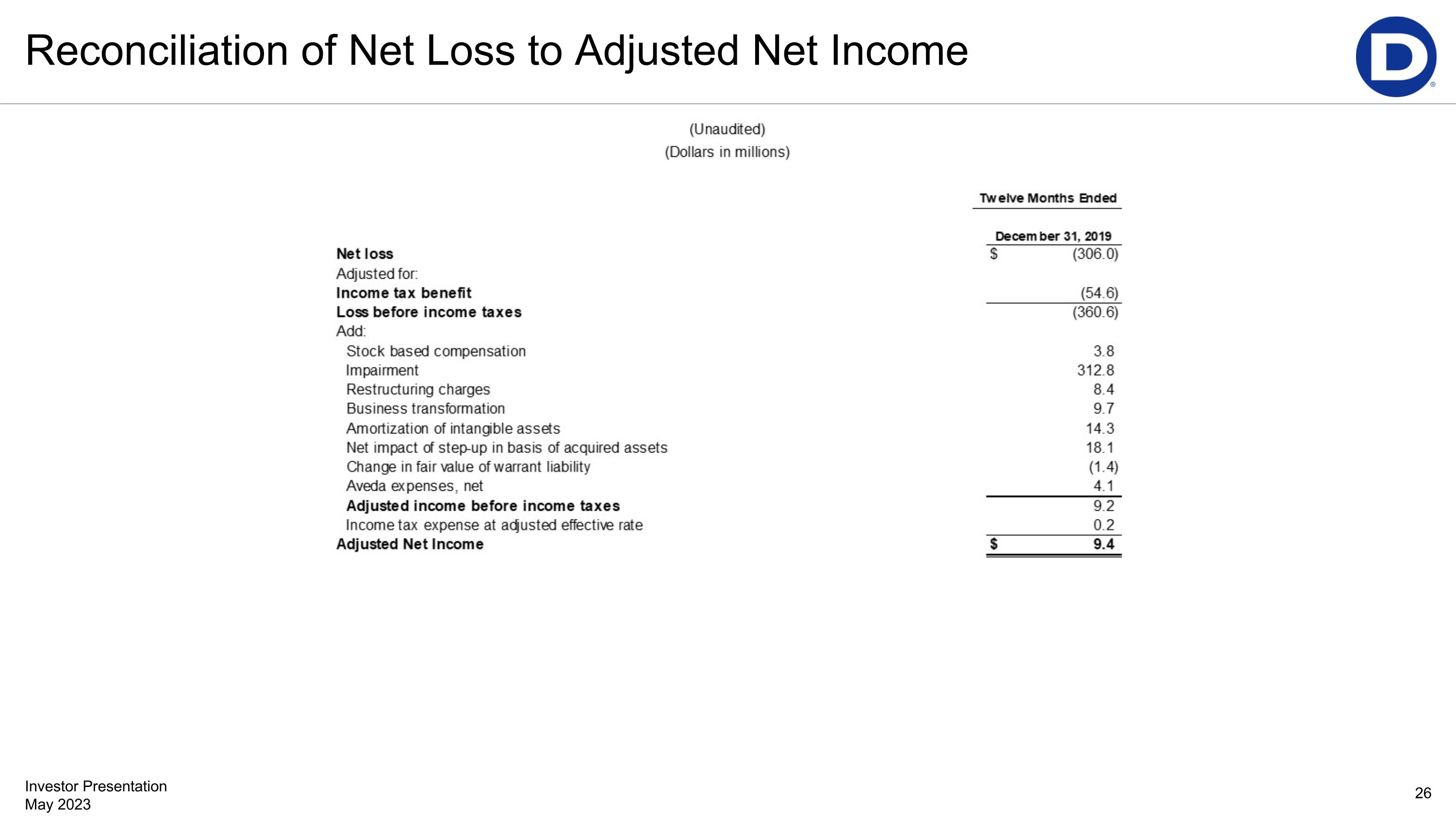
Reconciliation of Net Loss to Adjusted Net Income
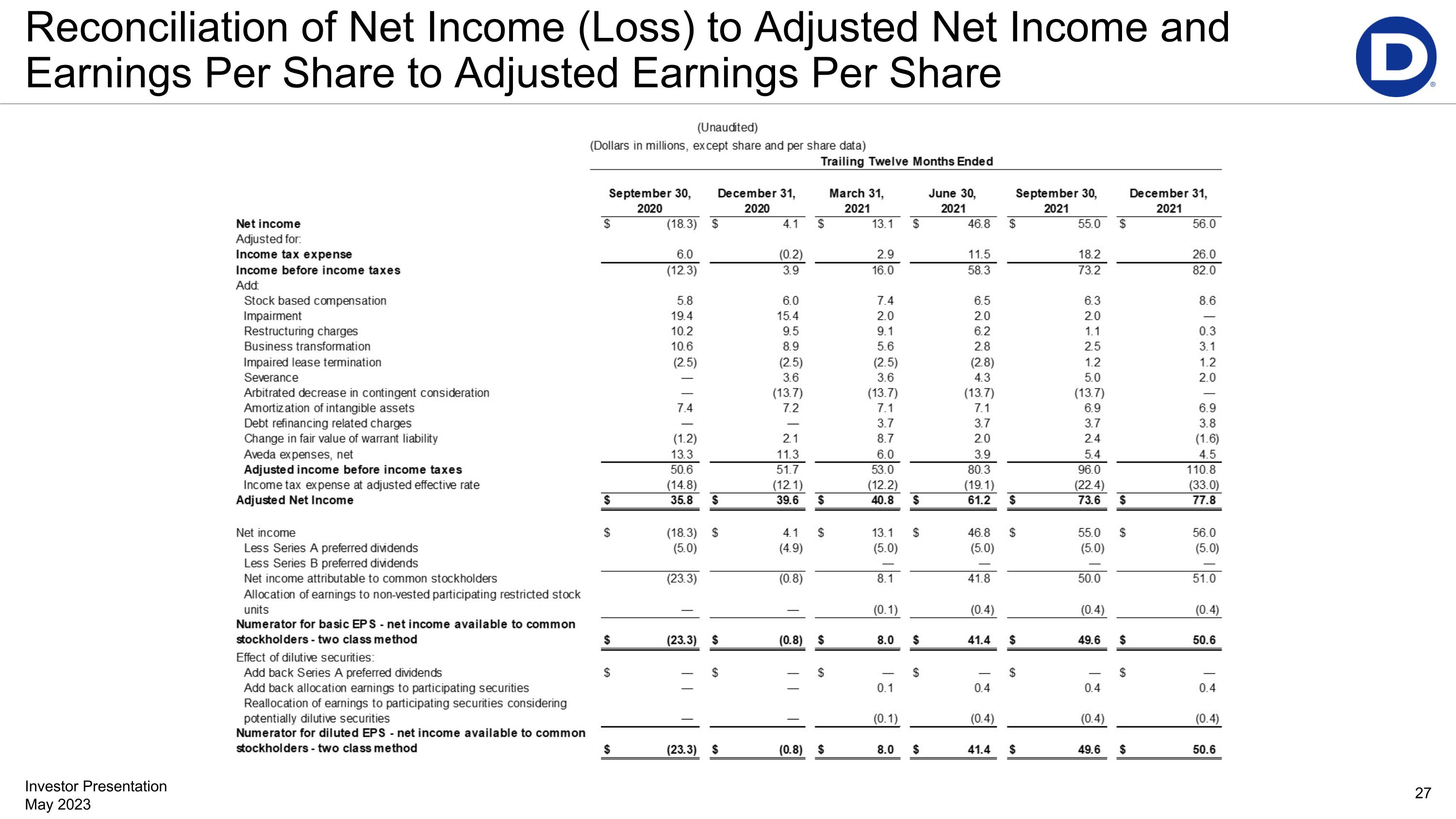
Reconciliation of Net Income (Loss) to Adjusted Net Income and �Earnings Per Share to Adjusted Earnings Per Share
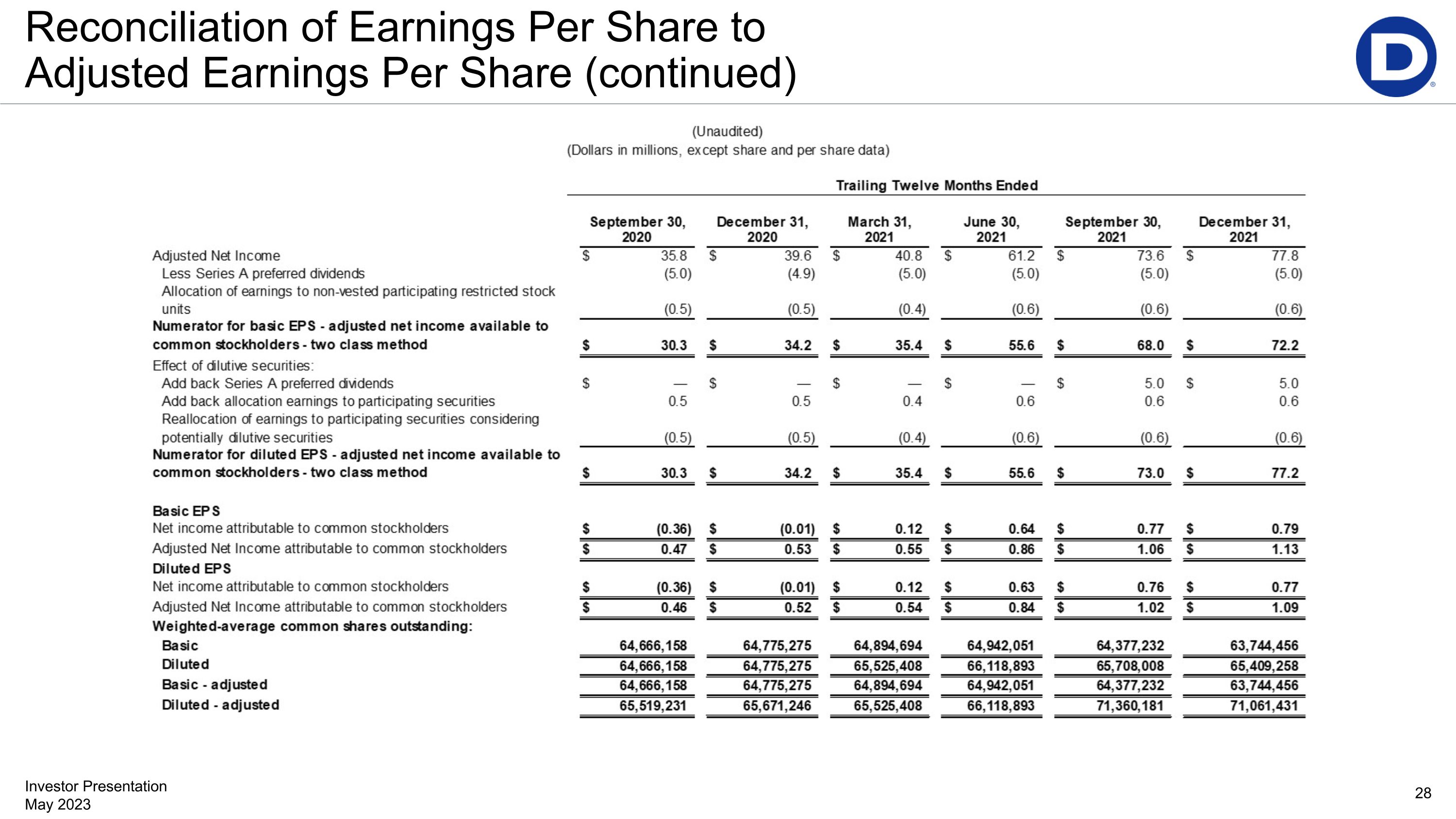
Reconciliation of Earnings Per Share to �Adjusted Earnings Per Share (continued)
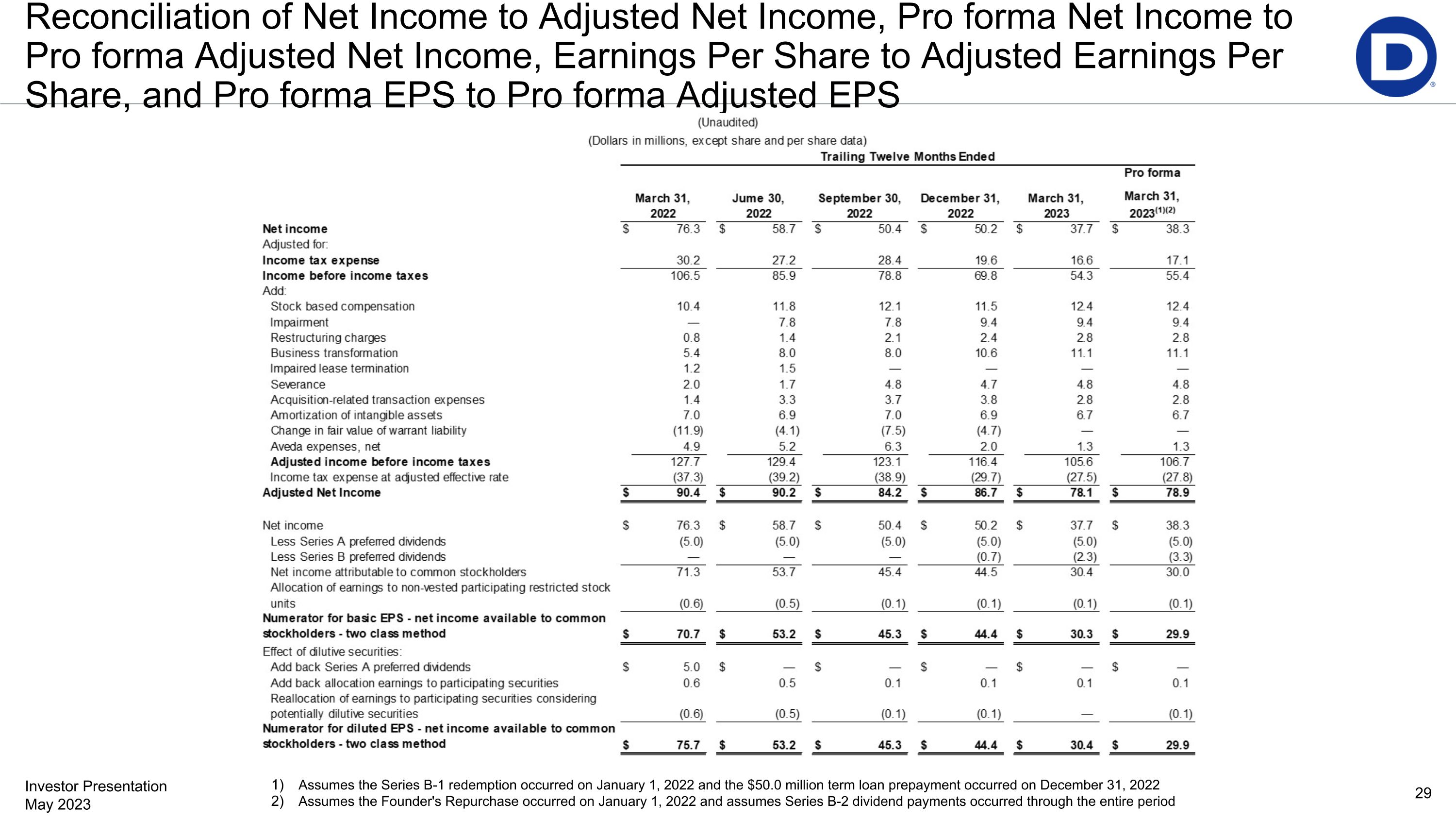
Reconciliation of Net Income to Adjusted Net Income, Pro forma Net Income to Pro forma Adjusted Net Income, Earnings Per Share to Adjusted Earnings Per Share, and Pro forma EPS to Pro forma Adjusted EPS Assumes the Series B-1 redemption occurred on January 1, 2022 and the $50.0 million term loan prepayment occurred on December 31, 2022 Assumes the Founder's Repurchase occurred on January 1, 2022 and assumes Series B-2 dividend payments occurred through the entire period
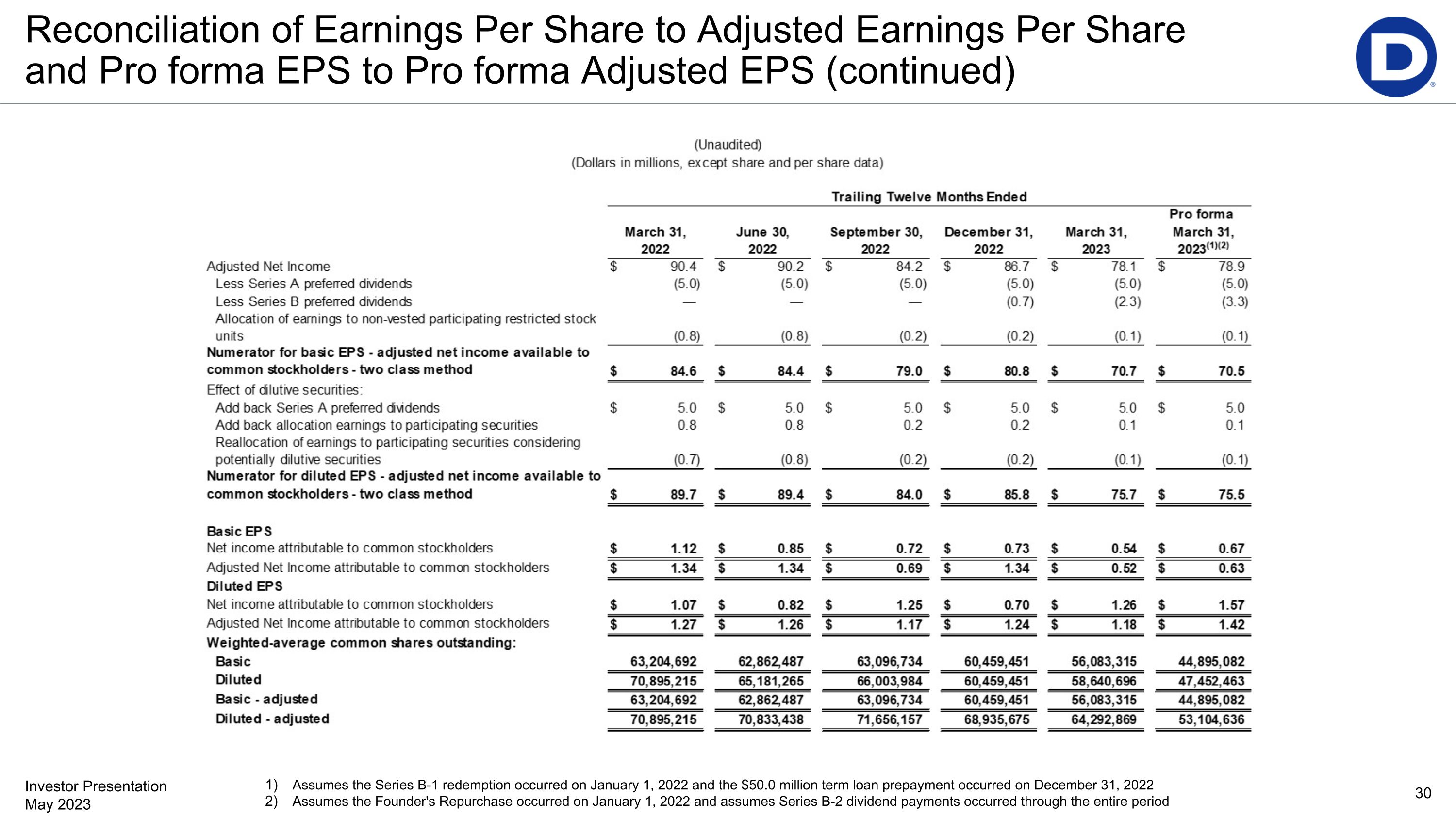
Reconciliation of Earnings Per Share to Adjusted Earnings Per Share and Pro forma EPS to Pro forma Adjusted EPS (continued) Assumes the Series B-1 redemption occurred on January 1, 2022 and the $50.0 million term loan prepayment occurred on December 31, 2022 Assumes the Founder's Repurchase occurred on January 1, 2022 and assumes Series B-2 dividend payments occurred through the entire period
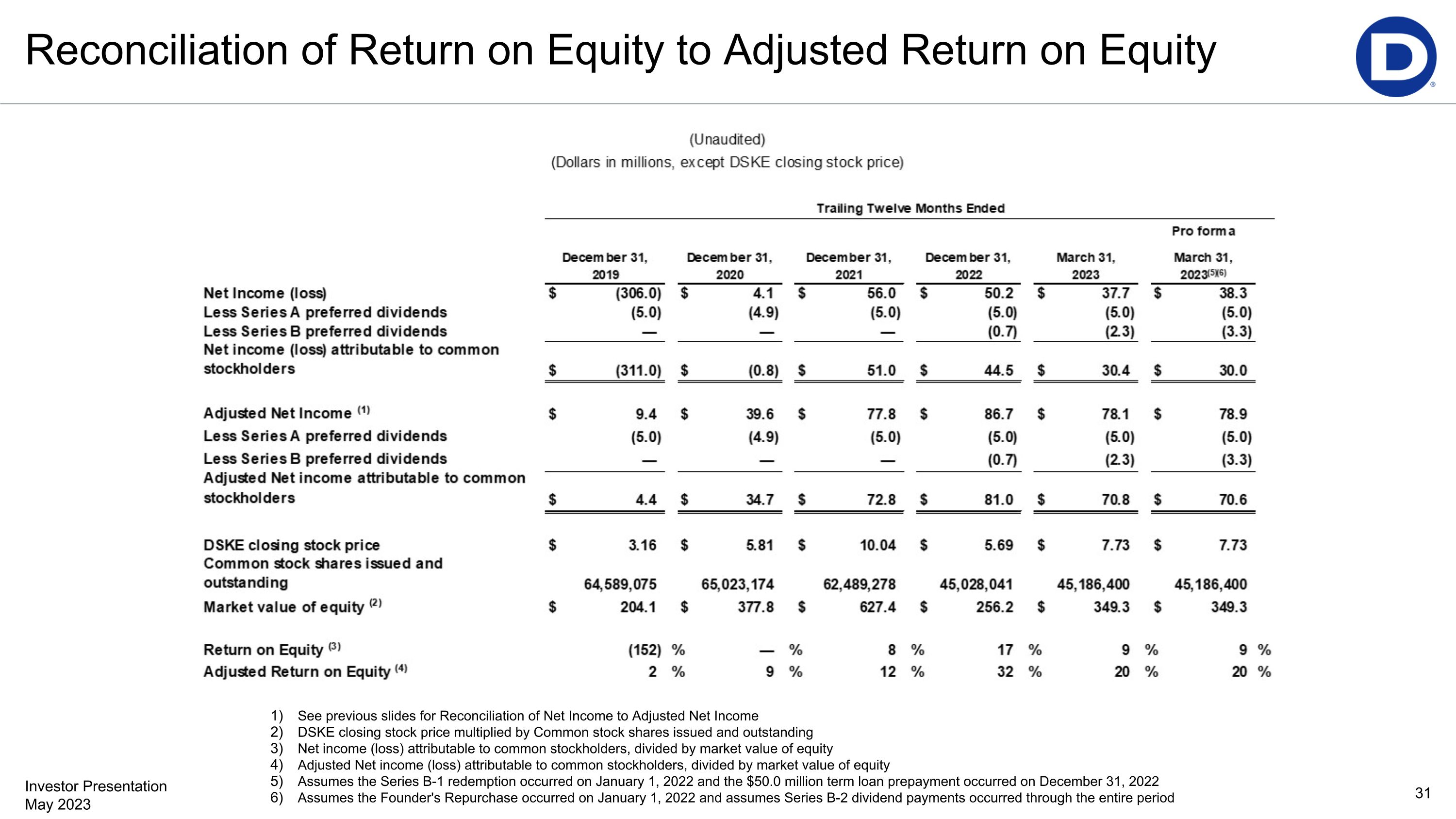
Reconciliation of Return on Equity to Adjusted Return on Equity See previous slides for Reconciliation of Net Income to Adjusted Net Income DSKE closing stock price multiplied by Common stock shares issued and outstanding Net income (loss) attributable to common stockholders, divided by market value of equity Adjusted Net income (loss) attributable to common stockholders, divided by market value of equity Assumes the Series B-1 redemption occurred on January 1, 2022 and the $50.0 million term loan prepayment occurred on December 31, 2022 Assumes the Founder's Repurchase occurred on January 1, 2022 and assumes Series B-2 dividend payments occurred through the entire period
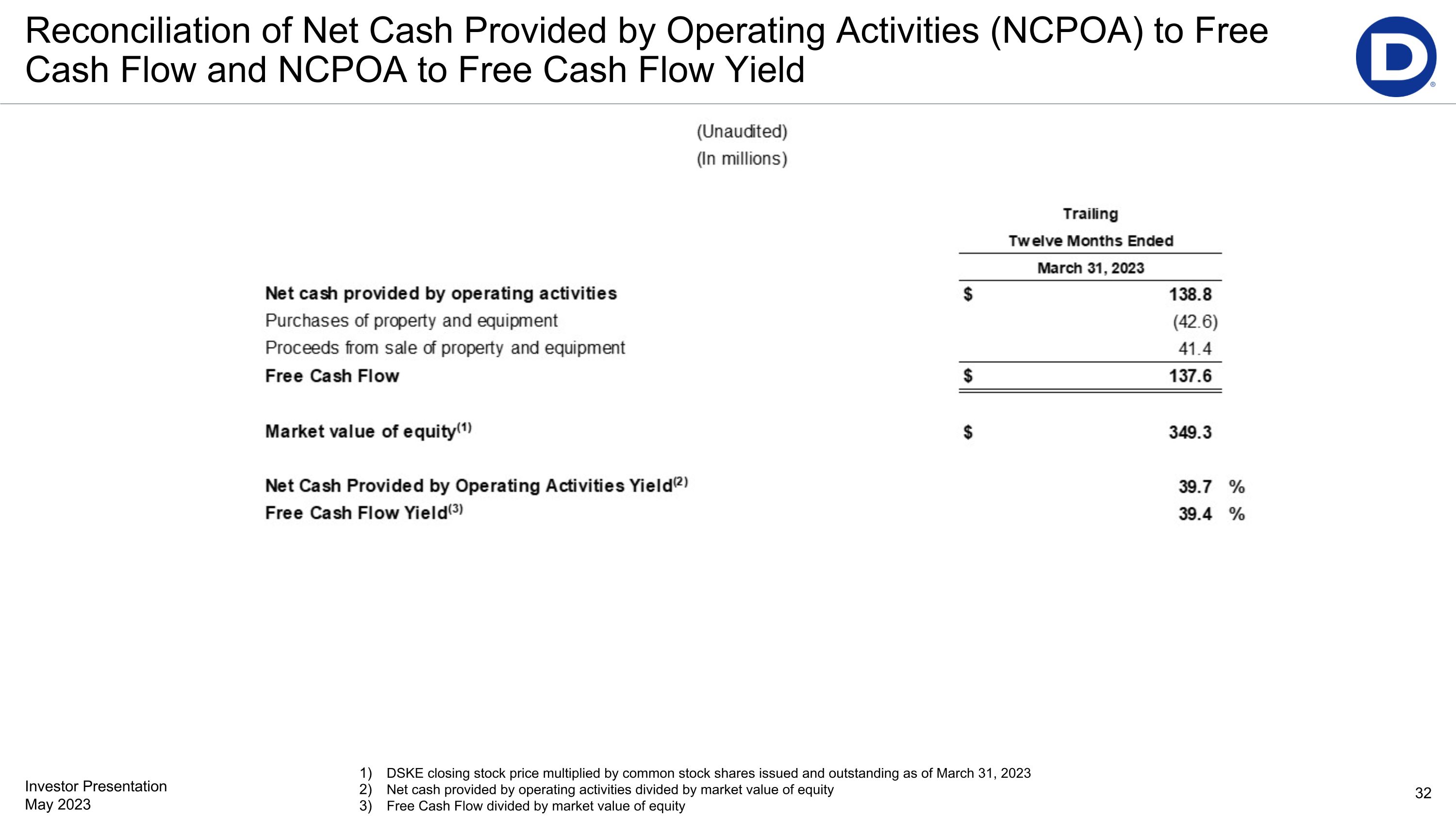
Reconciliation of Net Cash Provided by Operating Activities (NCPOA) to Free Cash Flow and NCPOA to Free Cash Flow Yield DSKE closing stock price multiplied by common stock shares issued and outstanding as of March 31, 2023 Net cash provided by operating activities divided by market value of equity Free Cash Flow divided by market value of equity
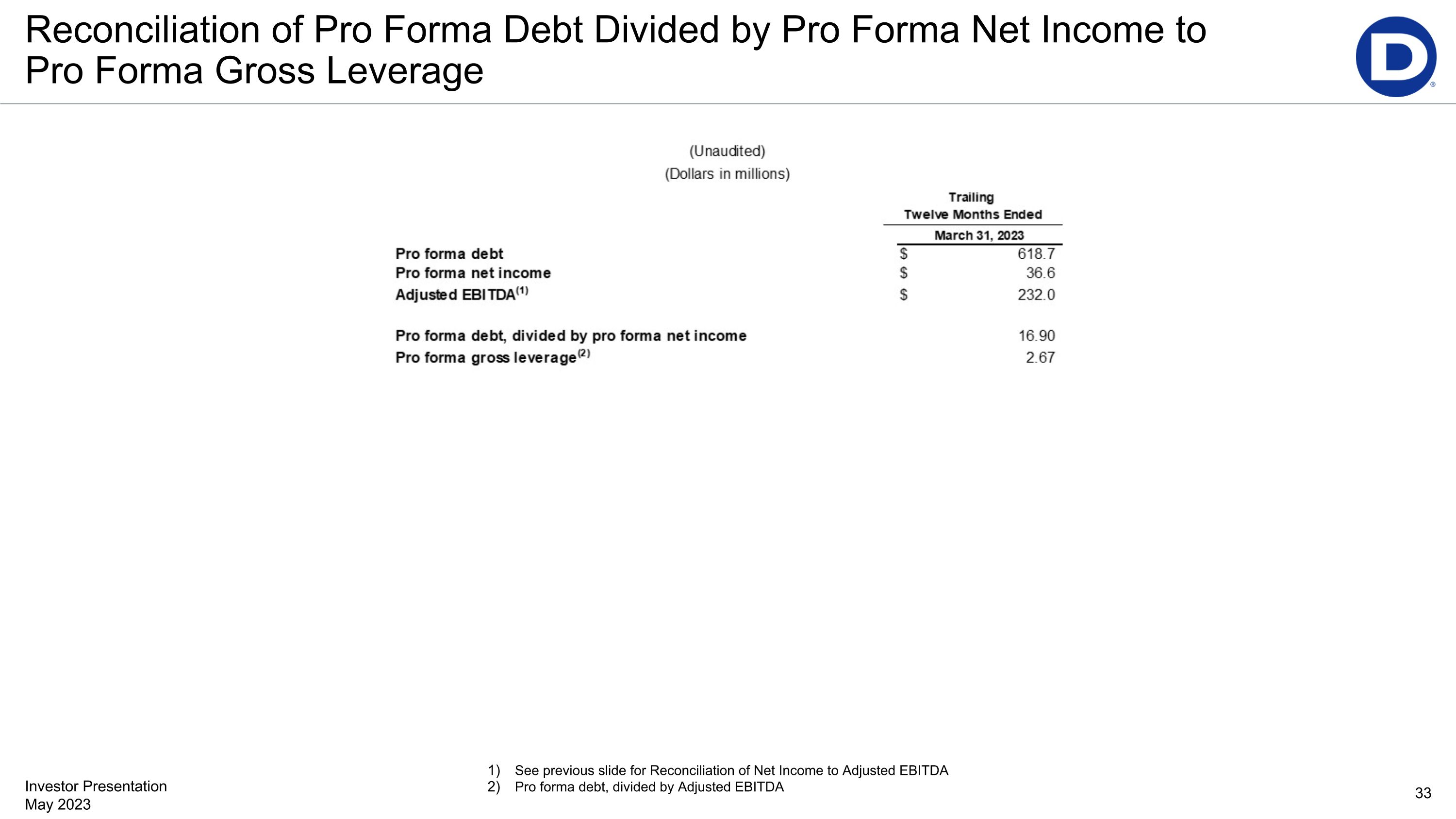
Reconciliation of Pro Forma Debt Divided by Pro Forma Net Income to �Pro Forma Gross Leverage See previous slide for Reconciliation of Net Income to Adjusted EBITDA Pro forma debt, divided by Adjusted EBITDA
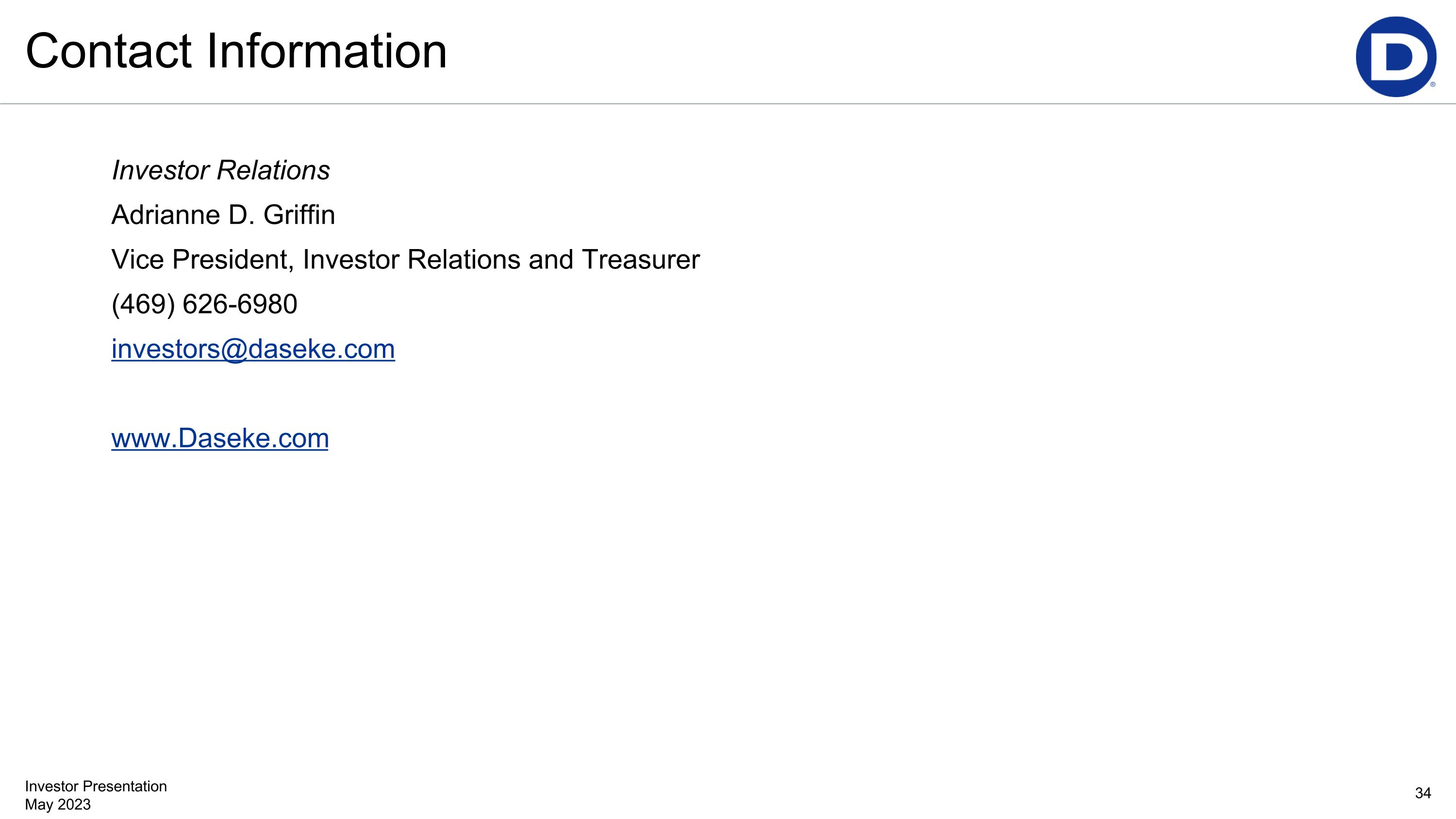
Contact Information Investor Relations Adrianne D. Griffin Vice President, Investor Relations and Treasurer (469) 626-6980 investors@daseke.com www.Daseke.com
v3.23.1
Document And Entity Information
|
May 09, 2023 |
| Cover [Abstract] |
|
| Document Type |
8-K
|
| Amendment Flag |
false
|
| Document Period End Date |
May 09, 2023
|
| Entity Registrant Name |
DASEKE, INC.
|
| Entity Central Index Key |
0001642453
|
| Entity Emerging Growth Company |
false
|
| Securities Act File Number |
001-37509
|
| Entity Incorporation, State or Country Code |
DE
|
| Entity Tax Identification Number |
47-3913221
|
| Entity Address, Address Line One |
15455 Dallas Parkway
|
| Entity Address, Address Line Two |
Suite 550
|
| Entity Address, City or Town |
Addison
|
| Entity Address, State or Province |
TX
|
| Entity Address, Postal Zip Code |
75001
|
| City Area Code |
(972)
|
| Local Phone Number |
248-0412
|
| Written Communications |
false
|
| Soliciting Material |
false
|
| Pre-commencement Tender Offer |
false
|
| Pre-commencement Issuer Tender Offer |
false
|
| Title of 12(b) Security |
Common Stock, par value $0.0001 per share
|
| Trading Symbol |
DSKE
|
| Security Exchange Name |
NASDAQ
|
| X |
- DefinitionBoolean flag that is true when the XBRL content amends previously-filed or accepted submission.
| Name: |
dei_AmendmentFlag |
| Namespace Prefix: |
dei_ |
| Data Type: |
xbrli:booleanItemType |
| Balance Type: |
na |
| Period Type: |
duration |
|
| X |
- DefinitionFor the EDGAR submission types of Form 8-K: the date of the report, the date of the earliest event reported; for the EDGAR submission types of Form N-1A: the filing date; for all other submission types: the end of the reporting or transition period. The format of the date is YYYY-MM-DD.
| Name: |
dei_DocumentPeriodEndDate |
| Namespace Prefix: |
dei_ |
| Data Type: |
xbrli:dateItemType |
| Balance Type: |
na |
| Period Type: |
duration |
|
| X |
- DefinitionThe type of document being provided (such as 10-K, 10-Q, 485BPOS, etc). The document type is limited to the same value as the supporting SEC submission type, or the word 'Other'.
| Name: |
dei_DocumentType |
| Namespace Prefix: |
dei_ |
| Data Type: |
dei:submissionTypeItemType |
| Balance Type: |
na |
| Period Type: |
duration |
|
| X |
- DefinitionAddress Line 1 such as Attn, Building Name, Street Name
| Name: |
dei_EntityAddressAddressLine1 |
| Namespace Prefix: |
dei_ |
| Data Type: |
xbrli:normalizedStringItemType |
| Balance Type: |
na |
| Period Type: |
duration |
|
| X |
- DefinitionAddress Line 2 such as Street or Suite number
| Name: |
dei_EntityAddressAddressLine2 |
| Namespace Prefix: |
dei_ |
| Data Type: |
xbrli:normalizedStringItemType |
| Balance Type: |
na |
| Period Type: |
duration |
|
| X |
- Definition
+ References
+ Details
| Name: |
dei_EntityAddressCityOrTown |
| Namespace Prefix: |
dei_ |
| Data Type: |
xbrli:normalizedStringItemType |
| Balance Type: |
na |
| Period Type: |
duration |
|
| X |
- DefinitionCode for the postal or zip code
| Name: |
dei_EntityAddressPostalZipCode |
| Namespace Prefix: |
dei_ |
| Data Type: |
xbrli:normalizedStringItemType |
| Balance Type: |
na |
| Period Type: |
duration |
|
| X |
- DefinitionName of the state or province.
| Name: |
dei_EntityAddressStateOrProvince |
| Namespace Prefix: |
dei_ |
| Data Type: |
dei:stateOrProvinceItemType |
| Balance Type: |
na |
| Period Type: |
duration |
|
| X |
- DefinitionA unique 10-digit SEC-issued value to identify entities that have filed disclosures with the SEC. It is commonly abbreviated as CIK. Reference 1: http://www.xbrl.org/2003/role/presentationRef
-Publisher SEC
-Name Exchange Act
-Number 240
-Section 12
-Subsection b-2
| Name: |
dei_EntityCentralIndexKey |
| Namespace Prefix: |
dei_ |
| Data Type: |
dei:centralIndexKeyItemType |
| Balance Type: |
na |
| Period Type: |
duration |
|
| X |
- DefinitionIndicate if registrant meets the emerging growth company criteria. Reference 1: http://www.xbrl.org/2003/role/presentationRef
-Publisher SEC
-Name Exchange Act
-Number 240
-Section 12
-Subsection b-2
| Name: |
dei_EntityEmergingGrowthCompany |
| Namespace Prefix: |
dei_ |
| Data Type: |
xbrli:booleanItemType |
| Balance Type: |
na |
| Period Type: |
duration |
|
| X |
- DefinitionCommission file number. The field allows up to 17 characters. The prefix may contain 1-3 digits, the sequence number may contain 1-8 digits, the optional suffix may contain 1-4 characters, and the fields are separated with a hyphen.
| Name: |
dei_EntityFileNumber |
| Namespace Prefix: |
dei_ |
| Data Type: |
dei:fileNumberItemType |
| Balance Type: |
na |
| Period Type: |
duration |
|
| X |
- DefinitionTwo-character EDGAR code representing the state or country of incorporation.
| Name: |
dei_EntityIncorporationStateCountryCode |
| Namespace Prefix: |
dei_ |
| Data Type: |
dei:edgarStateCountryItemType |
| Balance Type: |
na |
| Period Type: |
duration |
|
| X |
- DefinitionThe exact name of the entity filing the report as specified in its charter, which is required by forms filed with the SEC. Reference 1: http://www.xbrl.org/2003/role/presentationRef
-Publisher SEC
-Name Exchange Act
-Number 240
-Section 12
-Subsection b-2
| Name: |
dei_EntityRegistrantName |
| Namespace Prefix: |
dei_ |
| Data Type: |
xbrli:normalizedStringItemType |
| Balance Type: |
na |
| Period Type: |
duration |
|
| X |
- DefinitionThe Tax Identification Number (TIN), also known as an Employer Identification Number (EIN), is a unique 9-digit value assigned by the IRS. Reference 1: http://www.xbrl.org/2003/role/presentationRef
-Publisher SEC
-Name Exchange Act
-Number 240
-Section 12
-Subsection b-2
| Name: |
dei_EntityTaxIdentificationNumber |
| Namespace Prefix: |
dei_ |
| Data Type: |
dei:employerIdItemType |
| Balance Type: |
na |
| Period Type: |
duration |
|
| X |
- DefinitionLocal phone number for entity.
| Name: |
dei_LocalPhoneNumber |
| Namespace Prefix: |
dei_ |
| Data Type: |
xbrli:normalizedStringItemType |
| Balance Type: |
na |
| Period Type: |
duration |
|
| X |
- DefinitionBoolean flag that is true when the Form 8-K filing is intended to satisfy the filing obligation of the registrant as pre-commencement communications pursuant to Rule 13e-4(c) under the Exchange Act. Reference 1: http://www.xbrl.org/2003/role/presentationRef
-Publisher SEC
-Name Exchange Act
-Number 240
-Section 13e
-Subsection 4c
| Name: |
dei_PreCommencementIssuerTenderOffer |
| Namespace Prefix: |
dei_ |
| Data Type: |
xbrli:booleanItemType |
| Balance Type: |
na |
| Period Type: |
duration |
|
| X |
- DefinitionBoolean flag that is true when the Form 8-K filing is intended to satisfy the filing obligation of the registrant as pre-commencement communications pursuant to Rule 14d-2(b) under the Exchange Act. Reference 1: http://www.xbrl.org/2003/role/presentationRef
-Publisher SEC
-Name Exchange Act
-Number 240
-Section 14d
-Subsection 2b
| Name: |
dei_PreCommencementTenderOffer |
| Namespace Prefix: |
dei_ |
| Data Type: |
xbrli:booleanItemType |
| Balance Type: |
na |
| Period Type: |
duration |
|
| X |
- DefinitionTitle of a 12(b) registered security. Reference 1: http://www.xbrl.org/2003/role/presentationRef
-Publisher SEC
-Name Exchange Act
-Number 240
-Section 12
-Subsection b
| Name: |
dei_Security12bTitle |
| Namespace Prefix: |
dei_ |
| Data Type: |
dei:securityTitleItemType |
| Balance Type: |
na |
| Period Type: |
duration |
|
| X |
- DefinitionName of the Exchange on which a security is registered. Reference 1: http://www.xbrl.org/2003/role/presentationRef
-Publisher SEC
-Name Exchange Act
-Number 240
-Section 12
-Subsection d1-1
| Name: |
dei_SecurityExchangeName |
| Namespace Prefix: |
dei_ |
| Data Type: |
dei:edgarExchangeCodeItemType |
| Balance Type: |
na |
| Period Type: |
duration |
|
| X |
- DefinitionBoolean flag that is true when the Form 8-K filing is intended to satisfy the filing obligation of the registrant as soliciting material pursuant to Rule 14a-12 under the Exchange Act. Reference 1: http://www.xbrl.org/2003/role/presentationRef
-Publisher SEC
-Name Exchange Act
-Section 14a
-Number 240
-Subsection 12
| Name: |
dei_SolicitingMaterial |
| Namespace Prefix: |
dei_ |
| Data Type: |
xbrli:booleanItemType |
| Balance Type: |
na |
| Period Type: |
duration |
|
| X |
- DefinitionTrading symbol of an instrument as listed on an exchange.
| Name: |
dei_TradingSymbol |
| Namespace Prefix: |
dei_ |
| Data Type: |
dei:tradingSymbolItemType |
| Balance Type: |
na |
| Period Type: |
duration |
|
| X |
- DefinitionBoolean flag that is true when the Form 8-K filing is intended to satisfy the filing obligation of the registrant as written communications pursuant to Rule 425 under the Securities Act. Reference 1: http://www.xbrl.org/2003/role/presentationRef
-Publisher SEC
-Name Securities Act
-Number 230
-Section 425
| Name: |
dei_WrittenCommunications |
| Namespace Prefix: |
dei_ |
| Data Type: |
xbrli:booleanItemType |
| Balance Type: |
na |
| Period Type: |
duration |
|
This regulatory filing also includes additional resources:
dske-ex99_1.pdf
Daseke (NASDAQ:DSKEW)
Historical Stock Chart
From Apr 2024 to May 2024
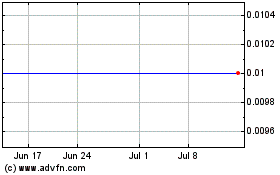
Daseke (NASDAQ:DSKEW)
Historical Stock Chart
From May 2023 to May 2024
